The 50 Most Romantic Movies Of All Time: Critics' Picks
- Oops!Something went wrong.Please try again later.
- Oops!Something went wrong.Please try again later.
- Oops!Something went wrong.Please try again later.
- Oops!Something went wrong.Please try again later.
- Oops!Something went wrong.Please try again later.
- Oops!Something went wrong.Please try again later.

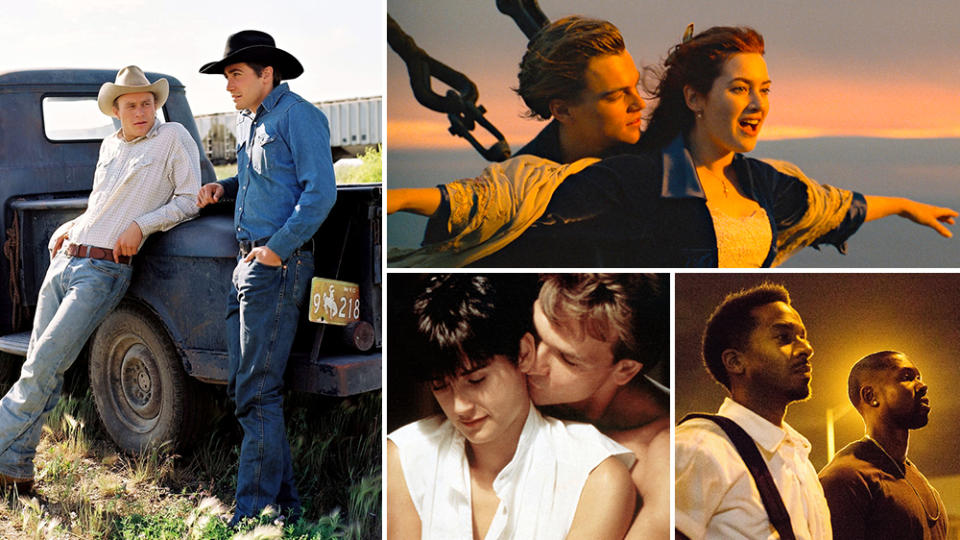
It’s the closest thing there is to a universal genre. That’s because, with rare exceptions, everyone falls in love, or at least wants to. And when you think about it, almost every movie is a love story. Thrillers, comedies, sci-fi — no matter what the form, the spectacle of two people falling in love in the middle of it has always been what makes the world of movies go round. That’s why choosing the greatest movie love stories presents a special challenge. Because really, what isn’t a contender? In a way, though, we kept our criteria simple. We were looking for grand passion, for chemistry and heat and all that good stuff. Yet there’s an ineffable quality that elevates a truly great movie romance. Let’s call it the Swoon Factor. It’s about the swoon that happens onscreen; it’s about the swoon that happens between the audience and the screen. What follows are the 50 films that, more than any others, got our hearts racing.
More from Variety
'The Notebook' Review: Broadway Musical of the Popular Romance Hits All-Too-Familiar Notes
How 'The Notebook' Broadway Musical Highlights the Universality of the Story's Enduring Romance
50. Dirty Dancing (1987)
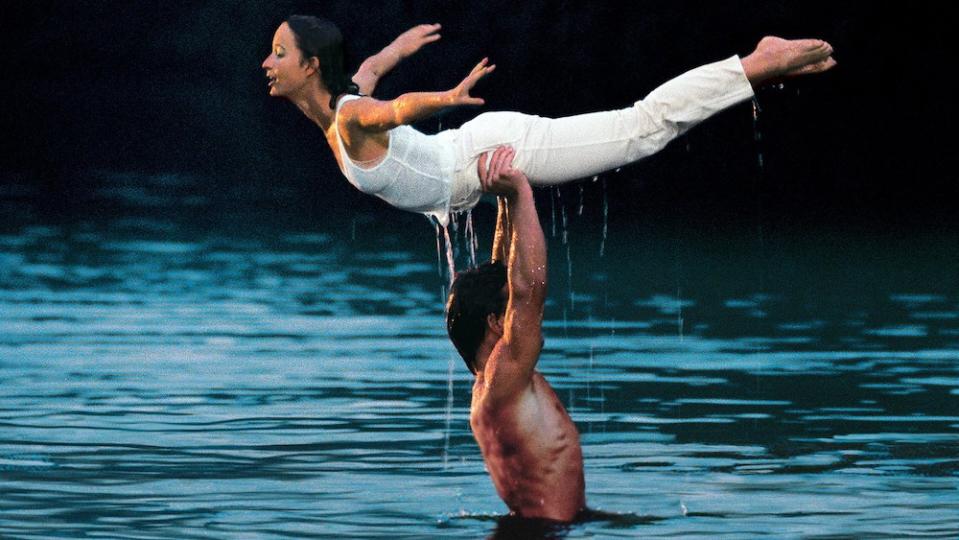
Set in 1963 but oh-so-’80s in its idea of hairstyles and heartthrobs, this sexy summer-camp romance defied its critics to become a classic. Nicknaming Jennifer Grey’s character “Baby” went a long way to illustrate what’s really going on here: The teenage daughter of conservative Jewish parents is forever being infantilized by her folks, until she meets a slightly older — but undeniably adult — dance teacher (Patrick Swayze) who shows her the time of her life. Corrupted by rock ’n’ roll, Baby grows up fast, getting over her initial shyness (“I carried a watermelon”) while rehearsing with her seductive instructor, who practices a racy new style of close-contact, ultra-suggestive moves that can only be read as carnal. Like “Rebel Without a Cause” and “Grease” before it, the movie plays on the fantasy of an off-limits attraction between Baby and the bad boy. — Peter Debruge
49. Trouble in Paradise (1932)
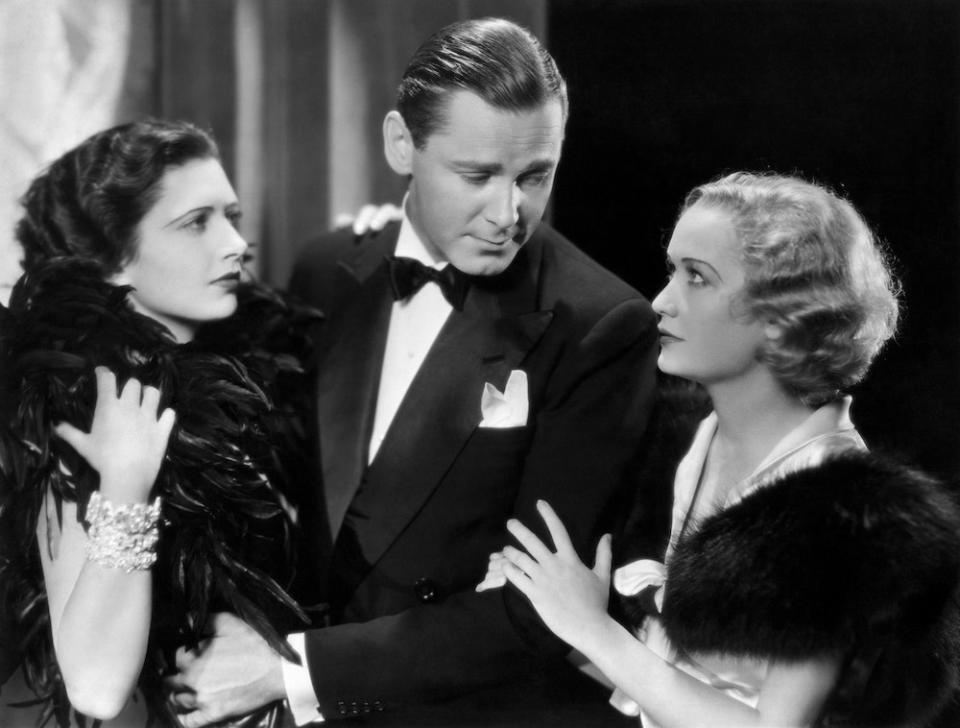
In this gold-standard screwball caper comedy, a gentleman thief, a lady pickpocket and a Parisian heiress form an elegant triangle, the preferred shape of Ernst Lubitsch — that sublime architect of romantic instability — who loved to test how seemingly solid couples might respond to a good romantic upset. Here, the temptation isn’t merely sentimental, as there’s a potential fortune on the line. What’s more, Gaston Monescu (Herbert Marshall) and Lily (Miriam Hopkins) make clear from the moment they meet that each is perfectly capable of robbing the other blind. She boosts his wallet, he knicks her garter (we needn’t see the deed to be scandalized). The movie came out before the Production Code, and it sparkles with the kind of naughty innuendo that was soon prohibited in Hollywood, but which Lubitsch was sophisticated enough to suggest even behind closed doors. — PD
48. Splash (1984)
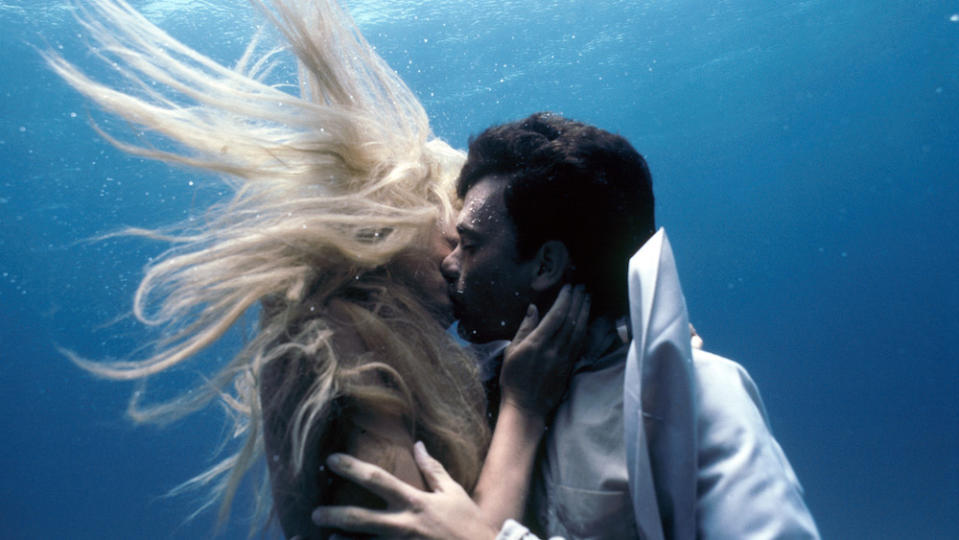
A man falls in love with a mermaid: What could be simpler, or sweeter, than that? Yet Tom Hanks, in the movie that made him a movie star, does not go lightly into his communion with a woman who’s half-fish. Ron Howard’s landmark comedy was one of the first films to demonstrate that a high-concept premise could be executed in a way that was artful and classic: a throwback to the Hollywood that used fantasy to put us in touch with reality. Daryl Hannah, as Madison the red-tailed mermaid, acts with a dazed curiosity and eagerness that’s irresistible, and Hanks turns his disgruntlement into a profound expression of love’s challenge – namely, that we can’t choose who we love, but we can choose to embrace the love that chose us. — Owen Gleiberman
47. The Bridges of Madison County (1995)

Amid a career of macho performances, Clint Eastwood tapped into his sensitive side to deliver one of his most indelible characters in Robert Kincaid, a National Geographic photographer on assignment in Iowa, who stops by a farmhouse to ask for directions. He’s greeted by Francesca, a lonely war bride who offers to show him around (an Italian-accented Meryl Streep, who says so much in her silent gestures, like the way she absentmindedly touches herself in the places she wants to be caressed). It’s no big surprise that this dissatisfied housewife develops feelings for this stranger. More touching is Kincaid’s admission that he’s fallen for Francesca, too, but knows she has no intention of leaving her family. Still, that doesn’t stop him from trying. “This kind of certainty comes but just once in a lifetime,” he tells her. The sight of Kincaid looking desperate in the rain, the downpour likely masking tears, is so radically counter-Eastwood, you’ve gotta believe it. — PD
46. The Notebook (2004)
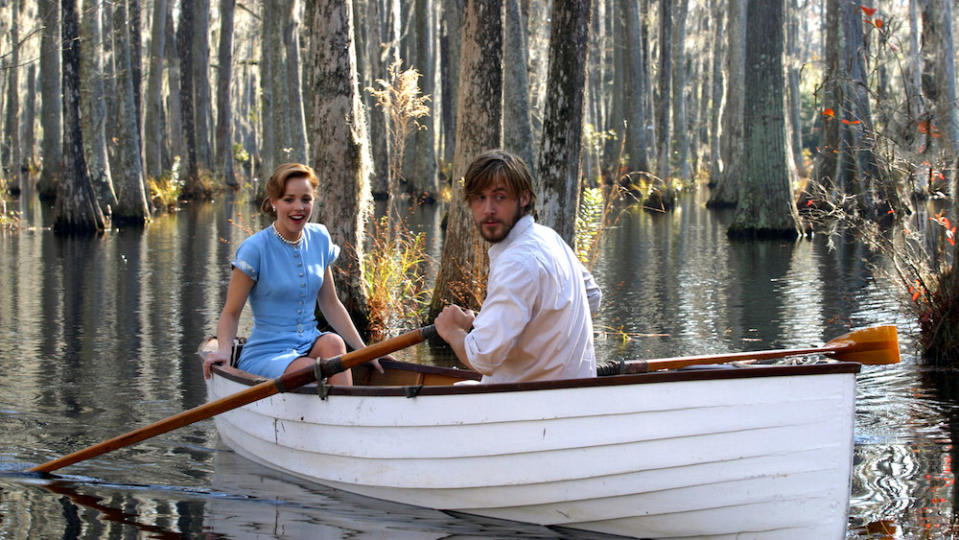
In the two decades since “The Notebook,” Ryan Gosling has cultivated his image as a chiseled heartthrob to such a degree that he seemed the perfect choice to play a live-action Ken doll in the “Barbie” movie. But back when director Nick Cassavetes was casting the role of Noah Calhoun, he saw the actor (and former Mouseketeer) differently — as someone both relatable and reckless enough to chase his dream girl (Rachel McAdams’ Allie) up a Ferris wheel. No matter what Allie does, he keeps on loving her in the best possible version Hollywood can make of a Nicholas Sparks novel. The secret formula here comes in catching up with Noah and Allie half a century later, as played by screen legends James Garner and Gena Rowlands, coupled with the tear-jerky reason we’ve been reliving all their most romantic memories. — PD
45. All That Heaven Allows (1955)
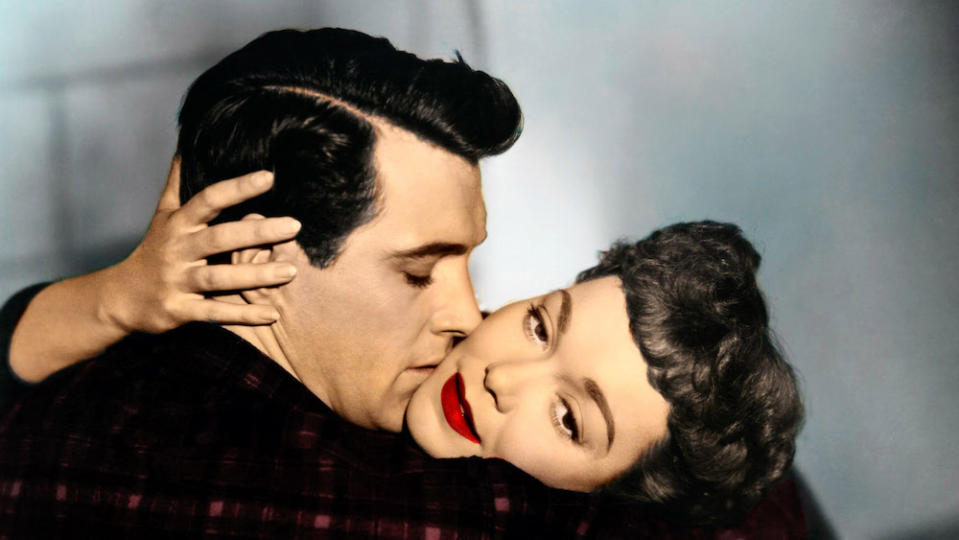
The colors gush in Douglas Sirk’s lush 1950s melodrama, about a New England widow, Cary (Jane Wyman), who falls for the studly but respectful hunk (Rock Hudson) who tends the trees at her house. It may be love, but her two grown children — and nearly the entire community — are disapproving of Cary’s feelings, pressuring her to break off the relationship. Seen today, neither the age difference nor the class divide seem like deal-breakers, which makes Cary’s sacrifice seem all the more futile. (Years later, Todd Haynes updated the dynamic with a Black gardener and a still-living gay husband in “Far from Heaven.”) During the 1950s, Hudson carved out a niche as a sensitive leading man, to the point that he’s almost pathetic here (consider the state of him in the final scene). Others may try to meddle, but in the end, it’s her decision alone whom she loves. — PD
44. The Sound of Music (1965)
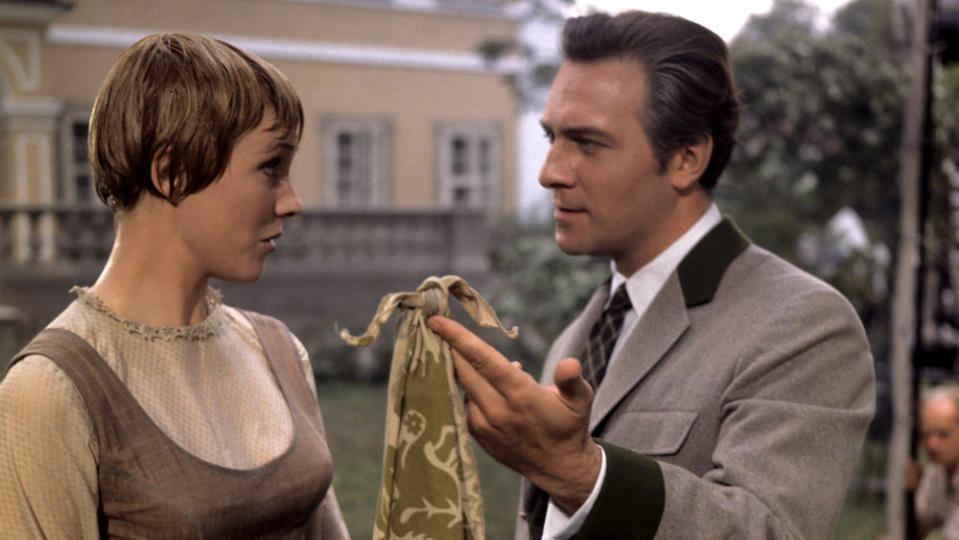
You might ask: How romantic could a musical this notoriously G-rated and squeaky-clean really be? But if “The Sound of Music” has incandescent songs, as well as a singular true-life story about the Von Trapp Family Singers (seven motherless Austrian children returned to vitality through the life force of Julie Andrews’ nun-turned-governess Maria), the movie’s secret weapon is its love story. Andrews, while she’s certainly playing the soul of goodness, invests her slow-blooming affection for Christopher Plummer’s Capt. Von Trapp with an almost forbidden sense of broken decorum. And Plummer, who looks like he belongs in a far darker movie, plays the captain as a lost man literally coming back to existence. When these two dance and realize, at the very same moment, that they’ve fallen in love, it’s one of the most electrifying scenes in movie history. — OG
43. Once (2007)
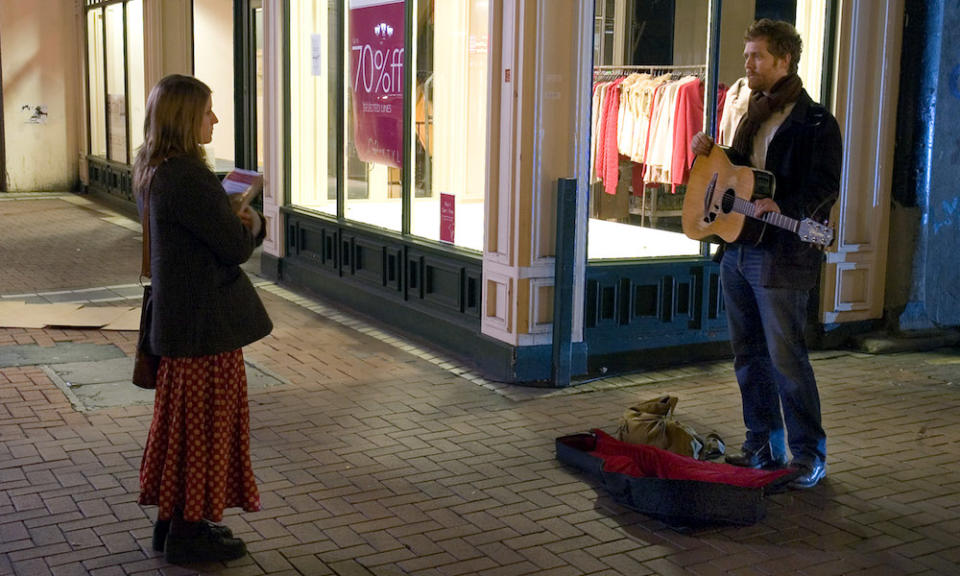
It’s not unusual to see a musical scale the heights of romantic passion. What’s different about John Carney’s film is that it’s a small-scale, non-stylized, kitchen-sink indie drama, yet in its lo-fi and platonic way it uses songs to create the majesty and devotion of a musical daydream. On the sidewalks of Dublin, a 30ish busker (Glenn Hansard) strums a guitar with a worn-out hole where the pick board should be. Most folks pass him by, but a girl (Markéte Irglová) lingers. They’re drawn into each other’s orbit, and though we never learn their names, a romance — or is it? — begins to play out in the songs they sing together. They both have other relationships, yet ”Once” tells the delicate tale of how, through song, these two save each other. As they give themselves over to numbers like “When Your Mind’s Made Up,” the movie swoons, and you will too. — OG
42. Pretty Woman (1990)
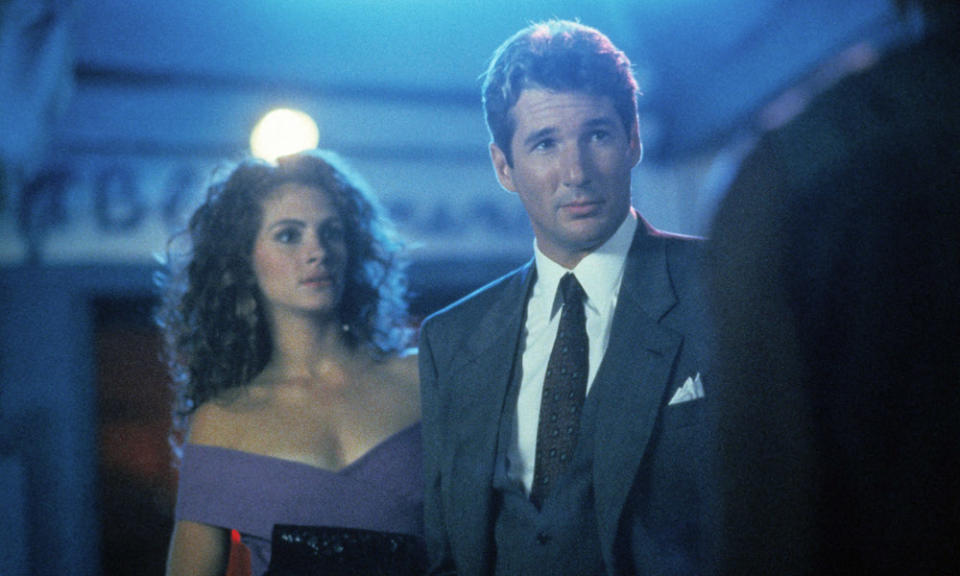
Some think of it as the ultimate guilty-pleasure rom-com. Others say that its story of a wealthy businessman (Richard Gere) who hires an escort (Julia Roberts) for a week to be his public romantic partner represents Hollywood at it most reprehensibly sexist. The truth, however, falls right in between. “Pretty Woman” only got tagged with the guilty-pleasure label because it came out at the dawn of the modern rom-com era (it sparkles like Tracy and Hepburn next to a lot of the films that came afterward). And as far as morality goes, it’s not the movie that’s sexist. It’s the world of high-gloss commodification that Vivian, played by Roberts not just with the boldest smile of her era but with the vivacity that turned her into a singular movie star, must navigate. Look closely at the dance of chemistry and arbitration between Roberts and Gere, and you’ll see that “Pretty Woman,” in its slickly-packaged-by-director-Garry Marshall way, is nothing less than a screwball celebration of the politics of love. — OG
41. Mississippi Masala (1991)
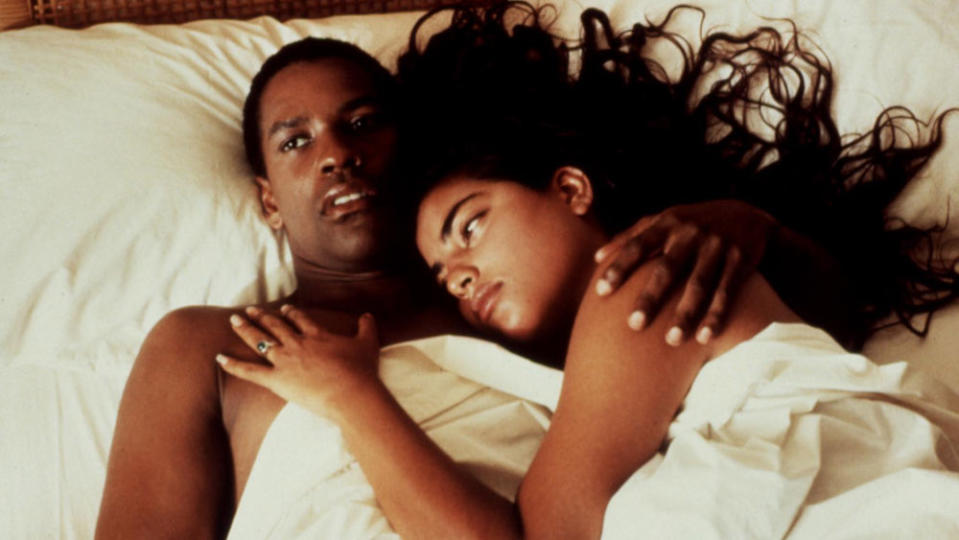
Mira Nair took a pioneering risk in depicting the romance between Demetrius (Denzel Washington), a blue-collar Black carpet cleaner, and Mina (Sarita Choudhury), a young Indian woman whose family fled Uganda to the American South. Set in Greenwood, Miss., where locals helped the creative team finesse the authenticity of the movie’s dialogue and detail, Nair’s contemporary interracial romance confronts the pushback of both the African American and South Asian communities to Demetrius and Mina’s relationship. But unlike Sidney Poitier social drama “Guess Who’s Coming to Dinner,” her parents’ reaction makes up just a fraction of the script, which gives complex backstories to each side of the couple. It’s also incredibly sexy, whether they’re chatting by phone in separate beds or sharing the same one in the movie’s scorching love scene. The movie argues for colorblindness while celebrating both cultures, modeling a relationship never before seen on screen. — PD
40. Say Anything (1989)
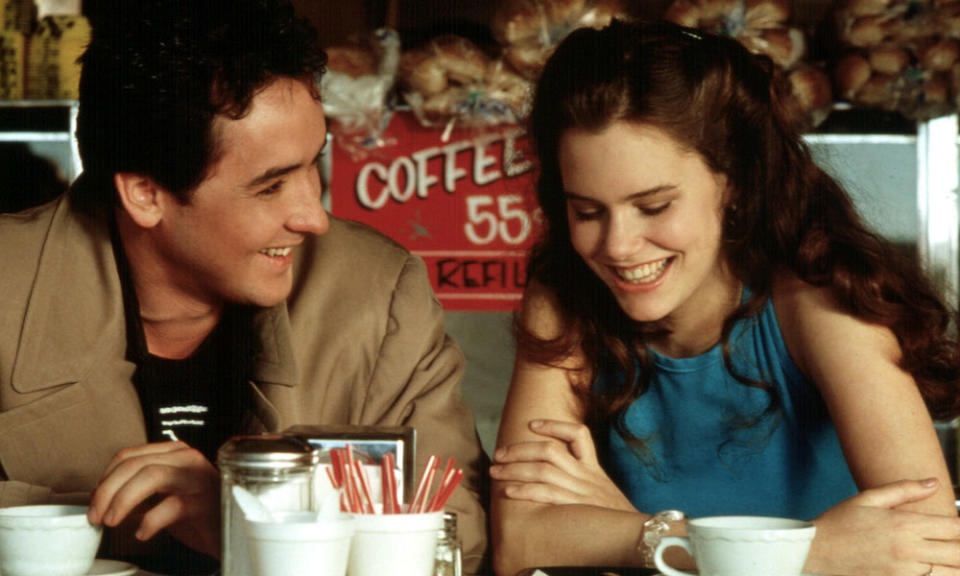
“Optimism is a revolutionary act,” writer-director Cameron Crowe quips in the commentary for his late-’80s teenage touchstone. That kind of radical confidence drives high school senior Lloyd Dobler (John Cusack), who musters the nerve to ask out valedictorian Diane Court (Ione Skye), even though all his peers think she’s out of his league. At first, Lloyd may seem like a nobody when compared to his most-likely-to-succeed sweetheart, but over time, he proves to be loyal, decent and unflappably sincere — qualities that made him the model boyfriend for kids of the ’80s. The clincher: Even when dumped, he shows up with a boombox, blasting Peter Gabriel’s “In Your Eyes” outside her window. The gesture became an iconic declaration of love for a generation … and still holds up, even if the technology is obsolete. — PD
39. The Way We Were (1973)
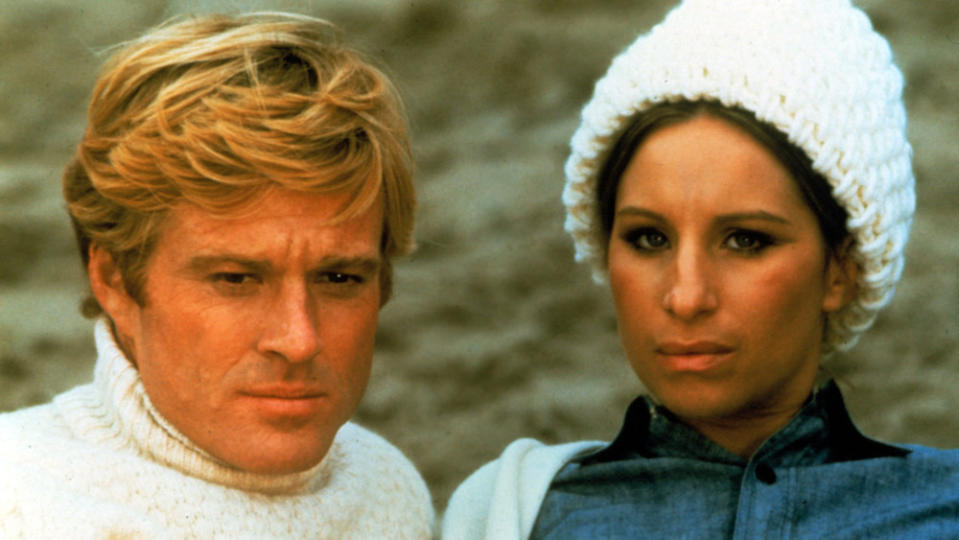
Today, it would probably be a rom-com about opposites attracting: Katie (Barbra Streisand), a wisecracking Marxist Jewish political activist, and Hubbell (Robert Redford), a debonair WASP writer born with the entitlement not to have to worry about “causes.” But 50 years ago, when the story was filmed by director Sydney Pollack not as a comedy but as a romantic drama of tumultuous love-hate passion, the film, in its high-end soap-opera way, seemed to be expressing something new in the culture — the way that love, after the 1960s, was no longer going to be asking people to stay in their ethnic lanes. “The Way We Were” is a hefty slice of middlebrow Hollywood corn, yet the irresistible tug of it is that Streisand and Redford embody their characters on a level of romantic mythology. And let’s not forget the power of that title song! As sung by Streisand, it’s the incarnation of nostalgic beauty. — OG
38. Carol (2015)
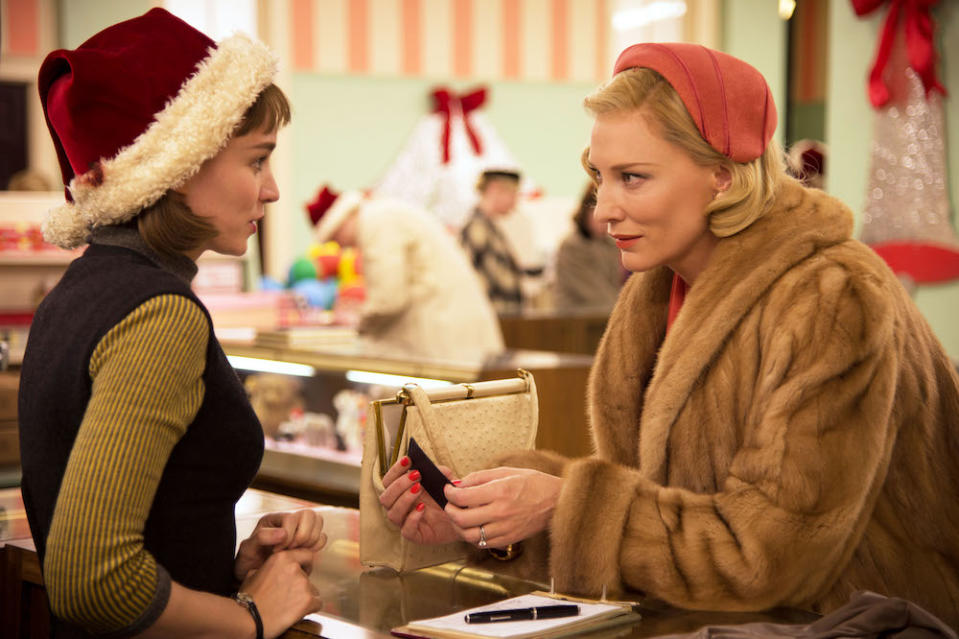
Movies that involve romantic stories of same-sex couples are inevitably placed in a category called “gay” or “queer” or whatever, often by their biggest fans. Yet if you think about it for five seconds, that’s a retrograde way of putting movies into boxes. The director Todd Haynes has made several masterpieces (“Far From Heaven,” “Superstar: The Karen Carpenter Story”), but he has never made a drama more darkly romantic and enticing, more seductive in its suspense, more mired in the agonizing compulsion of love than this lavishly mesmerizing adaptation of Patricia Highsmith’s 1952 novel “The Price of Salt.” During the Christmas shopping season, Therese (Rooney Mara), a New York department-store clerk, meets Carol, a woman of the world played by Cate Blanchett with a femme fatale swagger just this side of threatening. Their relationship will be fraught with the drama of divorce, blackmail, a private detective, and other elements that, as staged by Haynes, acquire the heightened quality of a vintage film noir. The final scene, set in the bar of the Oak Room, features one of the most transporting locked-gazes-across-a-crowded-room moments you’ll ever see. — OG
37. The Bodyguard (1992)
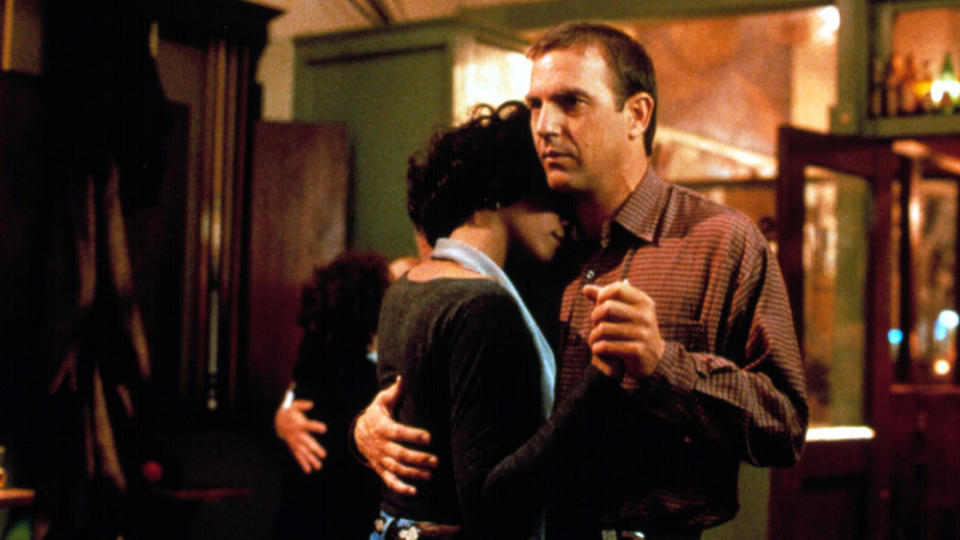
Is there anything more romantic than someone jumping in front of a bullet for you? Technically, that’s Frank Farmer’s job, but by the time Kevin Costner’s clean-cut, ex-Secret Service agent leaps in to protect endangered diva Rachel Marron (Whitney Houston) — on Oscar night, no less — we know he’s acting out of love more than duty. Frank sweeps both audiences and Rachel off their feet much earlier in the film, during a concert meltdown where he lifts her up and carries her through the mob — a chivalrous image immortalized on the film’s poster. Amazingly enough, “The Bodyguard” never made a big deal of its interracial romance, and that itself was a big deal. Powered by one of the all-time great soundtracks, the pop blockbuster is a classy entry in the oft-smarmy category of R-rated ’90s thrillers. Recent talks of a remake raise the question of which couple could out-sizzle Costner and Houston. — PD
36. Sunrise: A Song of Two Humans (1927)
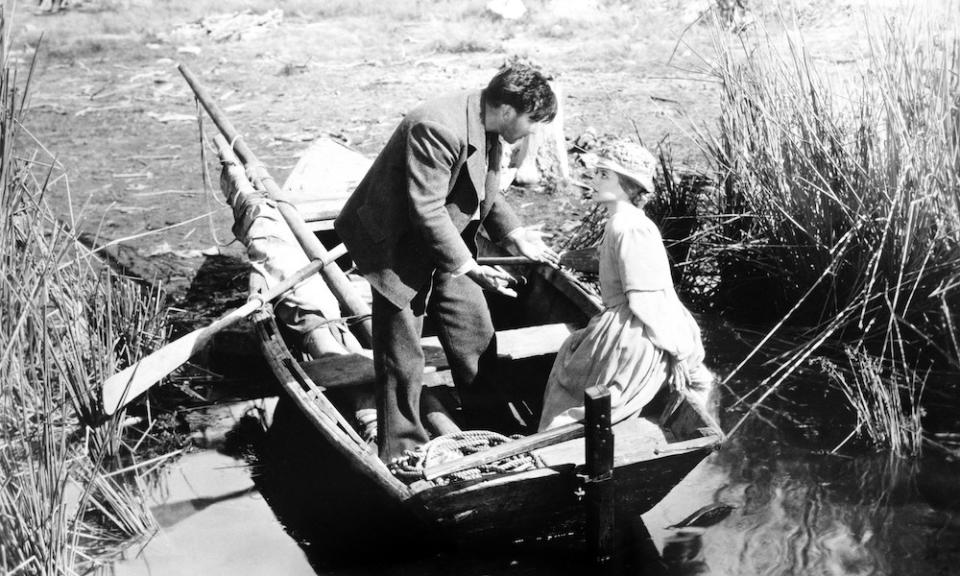
Marriage, they say, has its ups and downs. But it’s doubtful that any movie has ever dramatized the ebb and flow of feeling in a relationship with the primal power of F.W. Murnau’s silent classic. In outline, it could almost be a murderous film noir: A man — known only as The Man (George O’Brien), and haunted by better times with his wife, known only as The Wife (Janet Gaynor) — leaves the farmhouse where they live with their child to be with a woman from the city (Margaret Livingston). She wants him to drown The Wife, and part of the film’s shock is that he nearly does. But “Sunrise” proceeds as a series of shocks, which have the effect of jolting love back to life. Shot as a kind of sensuous living daydream, it is the cinema’s most profound and stirring roller-coaster of passion, an affirmation of what it means for two people to be meant for each other. — OG
35. The Princess Bride (1987)
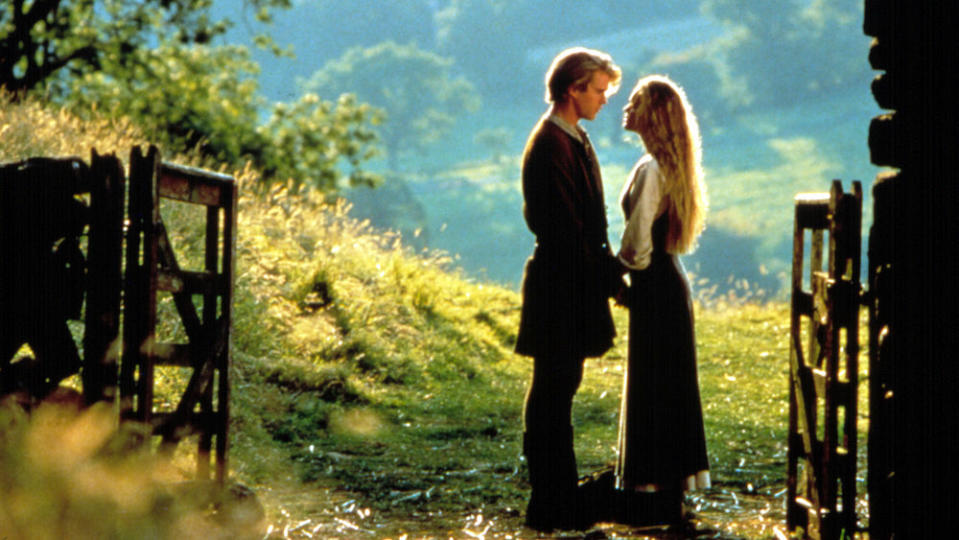
Presented as a beloved fairy tale passed down between generations, screenwriter William Goldman’s tongue-in-cheek riff on classic adventure tales takes the best parts of nearly a century of cinematic love stories and remixes them for the home-video set (the goal was to get through to media-savvy audiences who thought they’d seen it all). Starting with two impossibly beautiful leads in Cary Elwes and Robin Wright, he builds a legend of swashbuckling pirates, dangerous rescues and well-earned revenge, describing it all (via kindly narrator Peter Falk) as the ultimate example of the form. That’s an impossible tall order — a genre-straddling smorgasbord the studio didn’t know how to market at the time — which director Rob Reiner miraculously achieves by enlisting an astonishing ensemble. Everyone from Billy Crystal to Christopher Guest, Wallace Shawn to Andre the Giant assemble to support the sacrifice Westley makes to save his beloved Buttercup from marrying the wrong guy. — PD
34. Past Lives (2023)
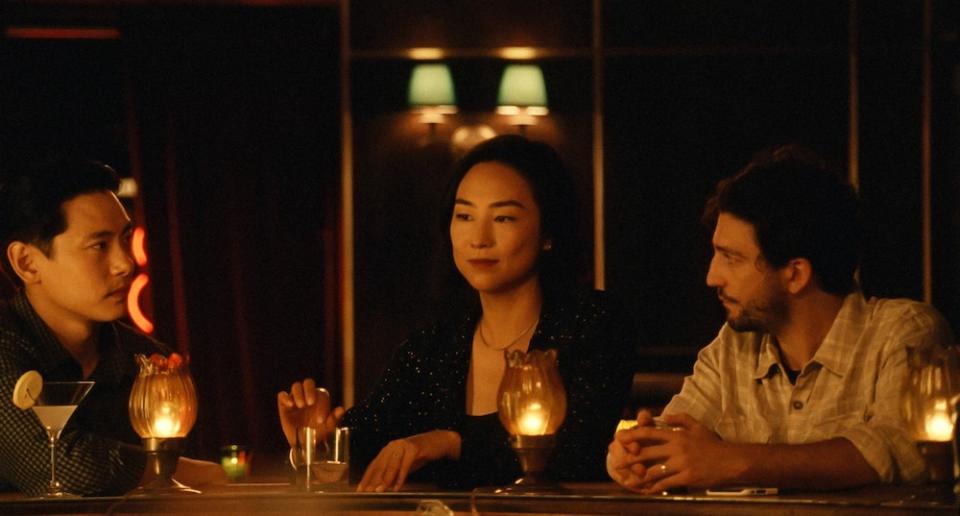
Two men and a woman sit at a bar, and before the audience knows anything about them, we try to figure out what their relationship is. Who belongs with whom? That we can’t entirely tell is key to what makes Celine Song’s remarkable drama such a haunting fable of love’s enigma. It turns out that Nora (Greta Lee), a New Yorker born and raised until the age of 12 in South Korea, is married to Arthur (John Magaro), a mouthy homegrown American she met at a writers’ retreat. The other man, Hae Sung (Teo Yoo), is the childhood friend Nora has maintained ties with; he’s at once her past, the spirit of her homeland, and maybe her romantic partner in another avenue of existence. “Past Lives” is a movie that will strike chords of recognition in any true romantic, as it’s about the secret journey that love takes: a communion that may occur in this life, or that may just be waiting for the next one. — OG
33. Beauty and the Beast (1946)

It’s one of the most poetic distillations of romantic desire in all of movies; you could also call it the “Splash” of its day. Jean Marais plays the Beast, who in Jean Cocteau’s film is a kind of delicate aristocrat with the face of a courtly lion. Josette Day is Belle, who ends up imprisoned in the Beast’s castle to work off a debt accrued by her father. What follows is an intricate fairy tale of deception and magic, built around the luminous ingenuity of Cocteau’s visual effects. Yet the most magical thing about it is the bond that develops between Belle and her disarmingly chivalrous captor/lover, a character so touching in his passion that when Greta Garbo saw the movie, it’s reported that she reacted to his death at the end by crying out, “Give me back my Beast!” — OG
32. Love & Basketball (2000)
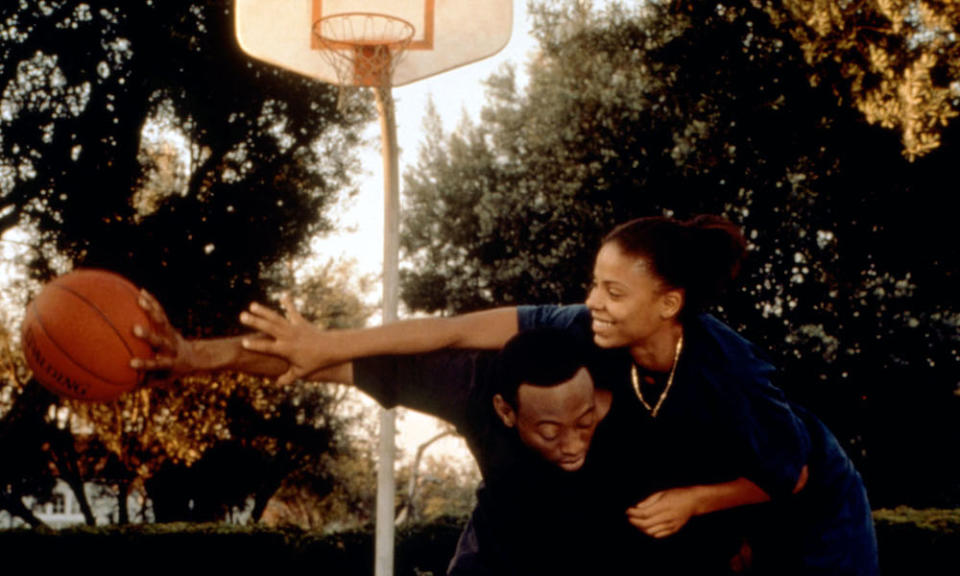
The title of this Y2K sports classic references two very different games, and the rules aren’t fair in either one. After discovering that they both love basketball, Monica cockily challenges childhood friend Quincy to a match (later, famously, she’ll play for his heart). Monica wins that first bout, but he winds up injuring her — an early sign that the dynamic is different when two sexes occupy the court at the same time. That gap widens as they grow up (into Omar Epps and Sanaa Lathan). He finds it relatively easy to follow in the footsteps of his NBA-pro dad, whereas there’s no equivalent path for female players. Writer-director Gina Prince-Bythewood empathizes with Monica, who watches fame go to her old friend’s head. Per the formula, audiences are conditioned to root for the romance to work out, but basketball occupies a bigger part of Monica’s heart, and the movie finds the perfect solution. — PD
31. Call Me by Your Name (2017)
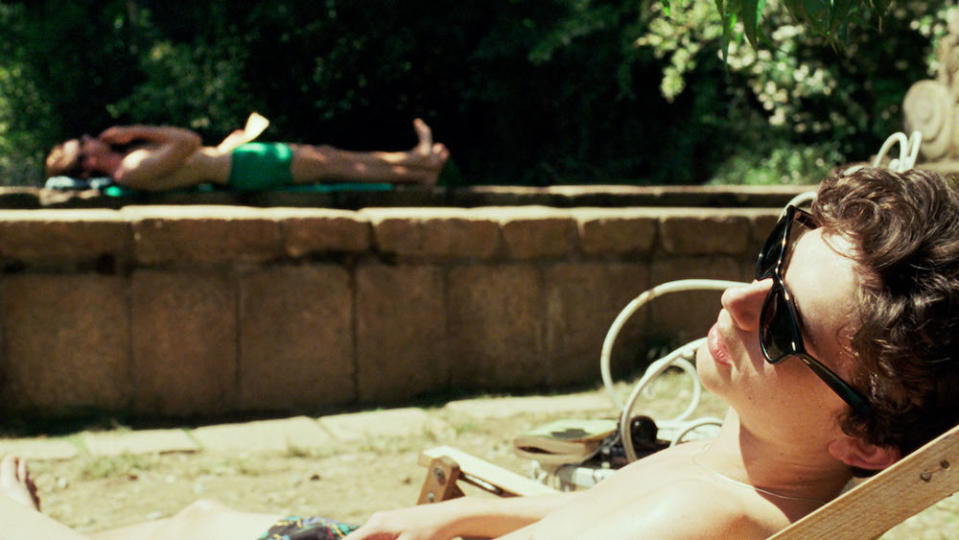
Italian director Luca Guadagnino (“I Am Love”) turned André Aciman’s ecstatic, wildly overwritten novel of a formative first love between teenage Elio (Timothée Chalamet) and his father’s slightly older — but still relatively inexperienced — teaching assistant, Oliver (Armie Hammer), into a sensual summer dream. There’s an intensity to the sights, sensations and emotions that imprints itself on audiences, such that Elio’s memories become our own. One needn’t be gay to recognize the significance that such an all-consuming early infatuation can leave on a young person’s romantic identity, though the movie offers a welcome message to all who’ve struggled to come to terms with their own sexuality in the eloquent heart-to-heart between the boy and his surprisingly understanding dad: “How you live your life is your business. Just remember, our hearts and our bodies are given to us only once,” he says. “Don’t kill it and with it the joy you’ve felt.” — PD
30. Vertigo (1958)
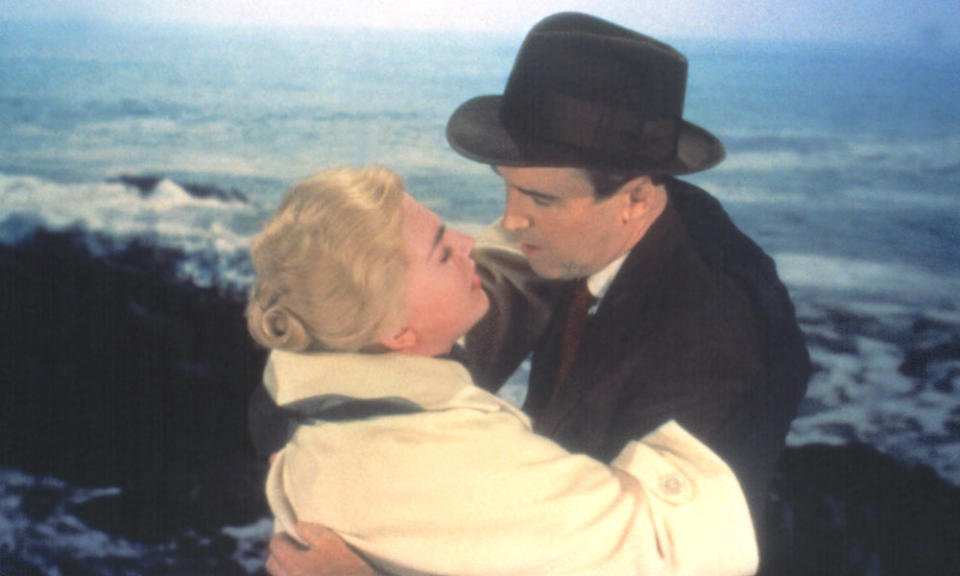
For a director who was known as the thrillingly precise and methodical Master of Suspense, Alfred Hitchcock was not shy about portraying romantic rapture. A number of his films (“To Catch a Thief,” “Notorious,” “Rear Window”) are entrancing love stories, but in “Vertigo” he dove deep into an almost private zone of love-as-fetishistic-obsession. James Stewart’s middle-aged detective falls for the woman he’s hired to follow — played, with a depressive carnality, by Kim Novak, who also plays the woman’s shop-girl look-alike, who Stewart then feels compelled to transform into the first woman. No classic Hollywood movie balances love on the precipice of kink and danger the way this one does, which is why “Vertigo” opened the door to everything from “Blue Velvet” to the career of Brian De Palma. — OG
29. La La Land (2016)
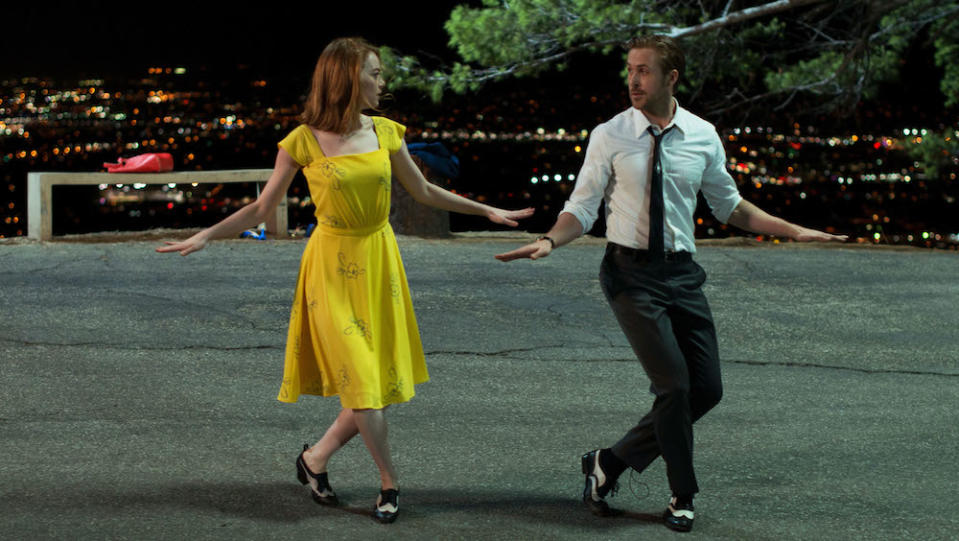
Damien Chazelle’s glorious, heartrending, bittersweet musical does an extraordinary job of retro-fitting the song-and-dance pleasures of vintage Hollywood into the sunlit freeway landscape of contemporary Los Angeles. Yet the film’s most radical feature is the way it brings Mia (Emma Stone), an aspiring actress, together with Seb (Ryan Gosling), a jazz pianist drowning in his own purity, and celebrates their union with intoxicating affection — only to show you how their love crashes on the shores of warring egos. What lifts “La La Land” into the realm of transcendently moving love stories is that it presents a happy ending that almost happened, and that could have happened if only life had turned out a bit different. — OG
28. Eternal Sunshine of the Spotless Mind (2004)
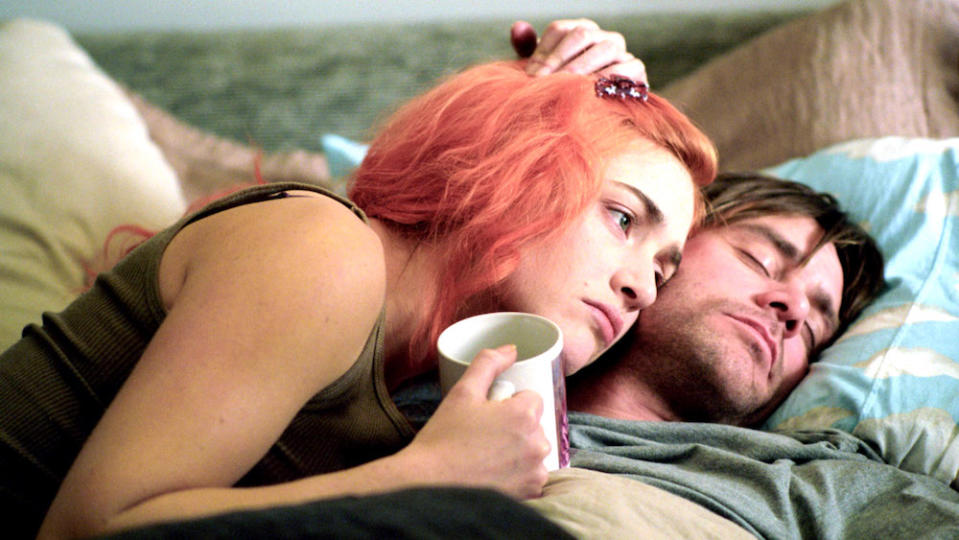
Dramatically speaking, the most exciting part of a relationship occurs either during the time a couple is falling in love or else at the moment it’s falling apart. Screenwriter Charlie Kaufman incorporates both aspects — albeit as endangered flashbacks — while exploring a fantasy that anyone who’s been through the emotional wringer of a relationship can identify with: What if you could erase all traces of an ex from your memory? Director Michel Gondry proved the perfect partner to visualize the sketchy sci-fi apparatus that makes a brain scrub possible for Joel (Jim Carrey), who realizes halfway through that, however painful, he can’t live without any trace of his soulmate, Clementine (Kate Winslet), the manic free spirit with the Kool-Aid-colored hair. As Joel tries to hold on to the good times while his mind’s being wiped, Kaufman allows audiences to absorb their best memories and make them our own. — PD
27. Four Weddings and a Funeral (1994)
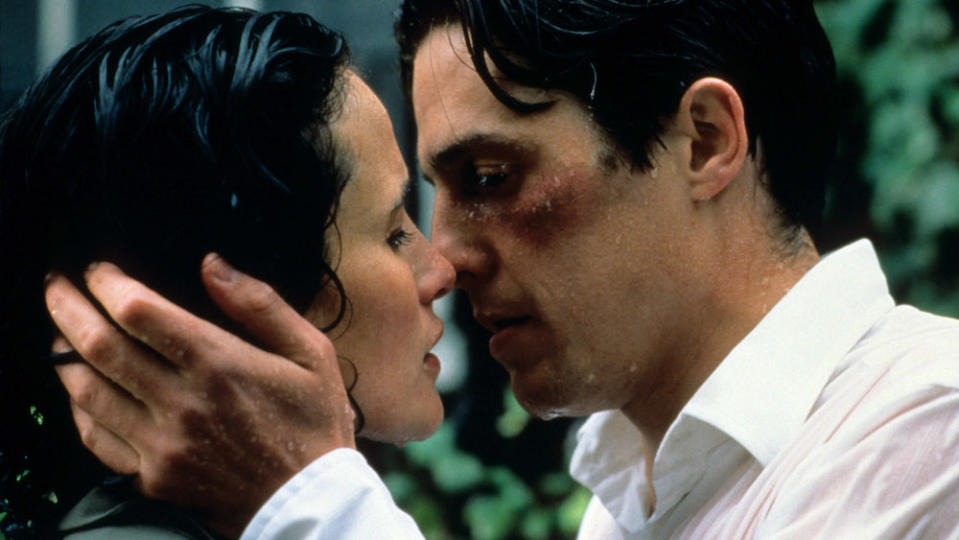
Hugh Grant stammered his way into our hearts, fumbling and fluttering his eyelids the whole way, in a delightfully English rom-com from screenwriter Richard Curtis (who juggled no fewer than eight couples in his 2003 directorial debut “Love Actually”). This more streamlined love story starts where practically every Jane Austen story ends: at the altar. Grant’s not the one getting hitched at those opening nuptials, though he does fall hard for an American guest played by Andie MacDowell. Their courtship is unconventional (it amounts to shagging anytime their friends tie the knot), but the chemistry is undeniable. When it’s time for Charles and Carrie to get married, however, each of them says their vows with someone else. So how do they wind up together? It’s the little surprises that delight. — PD
26. Out of Sight (1998)

In terms of sheer sex appeal, it’s hard to top the chemistry between George Clooney and Jennifer Lopez, who play an incorrigible bank robber and the U.S Marshall tasked with apprehending him in Steven Soderbergh’s sultry, time-skipping Elmore Leonard adaptation. It’s steamy from the start, as a prison break leaves cop and quarry stuffed in a trunk together — a cozy way to get acquainted. Four years after “Pulp Fiction,” the picture came at a moment when Soderbergh was experimenting with film editing and features several nifty innovations, including an unconventional love scene that turns up the heat by cutting between flirtation and payoff. In one thread, Jack Foley and Karen Sisco roleplay in the hotel bar, pretending to be strangers. Skipping ahead, it teases glimpses of the “time out” where all this cocktail talk is headed: a striptease upstairs, in which the pair put aside their differences long enough to make love. — PD
25. The Unbearable Lightness of Being (1988)
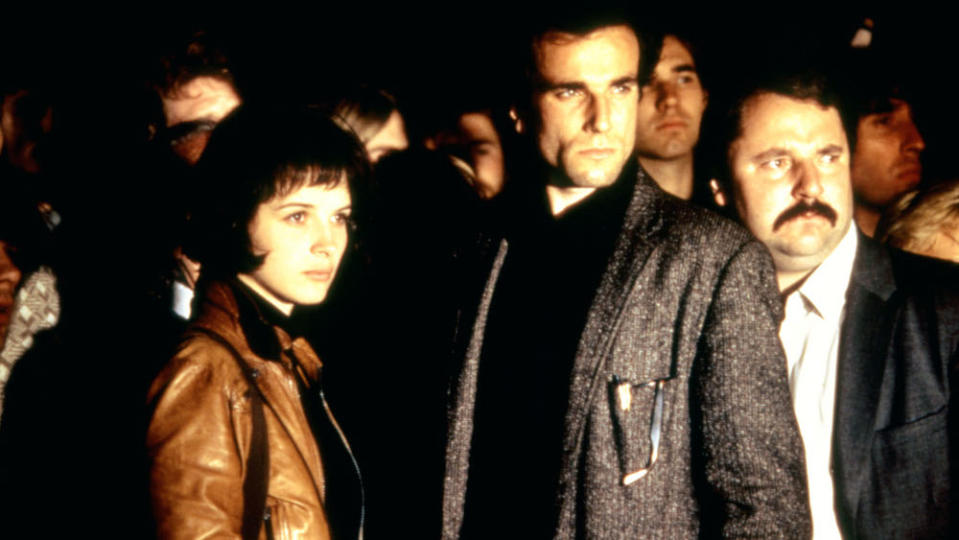
Great as he is, we don’t tend of think of Daniel Day-Lewis as an overwhelmingly romantic movie star. In Philip Kaufman’s heady, intoxicating, high-wire adaptation of the Milan Kundera novel, he plays Tomas, a character who is very much a fickle Lothario — a randy physician in 1960s Prague who bounces from one conquest to the next, though he does have a regular thing going with Sabine (Lena Olin), an artist who likes to spice their lovemaking with mirrors and bowler hats. But then Tomas meets Tereza (Juliette Binoche), whose gravity pulls him down to earth. And then the Soviet tanks come rolling in, blowing up all their lives. When that happens, “The Unbearable Lightness of Being” becomes one of the most seriously moving love stories in cinema, a tale of three lost souls yearning to connect, to survive, to unlock love’s mystery. — OG
24. A Star Is Born (1954)
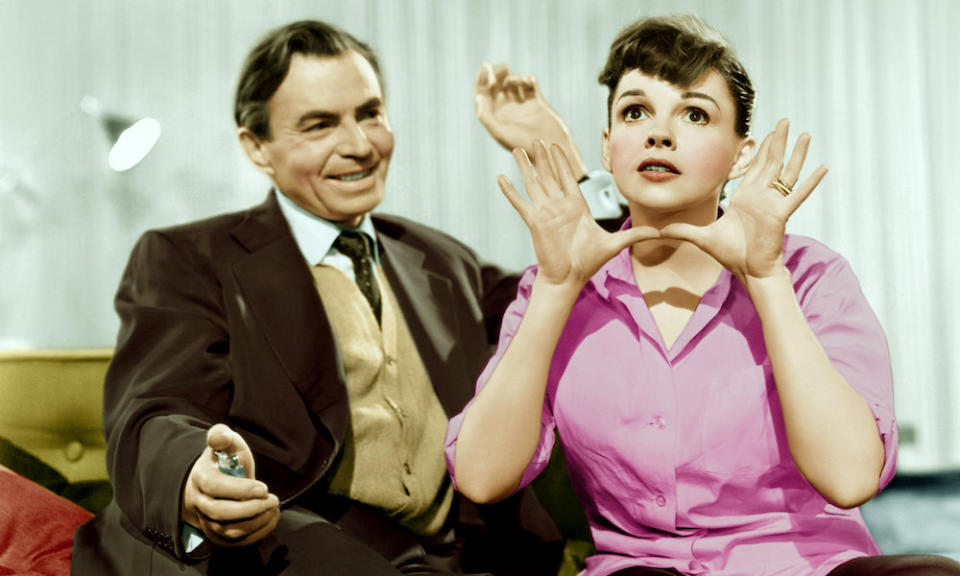
For 30 years, the Judy Garland/James Mason version of “A Star Is Born” was tainted by the messy circumstances of its making. The script kept getting rewritten, Garland was a notoriously unstable presence on set, and when the movie premiered in New York, it was three hours long — but executives at Warner Bros. then chopped it by half an hour, without so much as consulting the director, George Cukor. Yet when the movie was re-released in the ’80s, its reputation was elevated in a way that’s comparable to what happened with Hitchcock’s “Vertigo.” A world of moviegoers discovered that Cukor had crafted one of the most darkly entrancing love stories ever made. Its haunted spirit of rapture and loss is incarnated in Garland’s performance of “The Man That Got Away,” in Mason’s jaw-dropping drunken slap of Garland during a scene set at the Oscars, and in the tragic finale, which touches the secret heart of love: the faith necessary to sustain it. — OG
23. The Remains of the Day (1993)
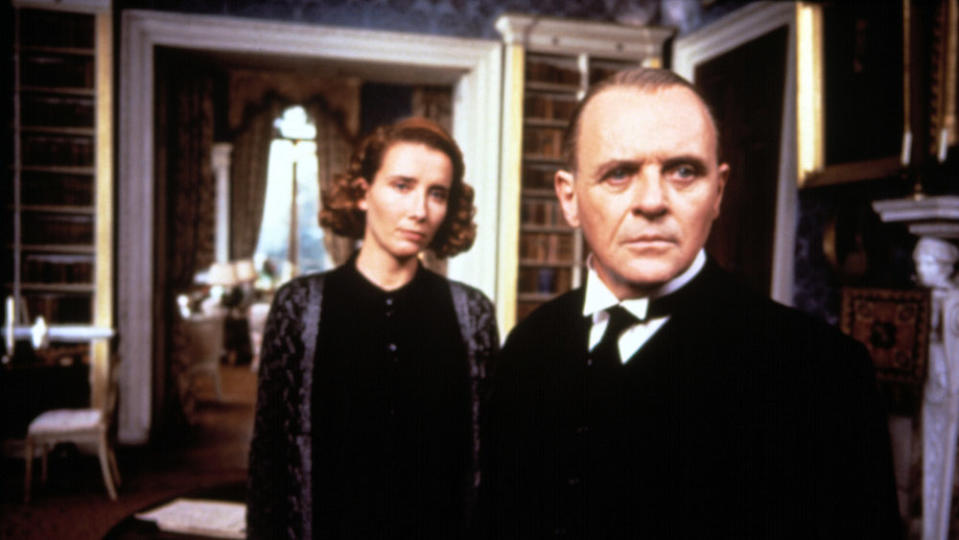
Repression and strict social restraints are constantly keeping lovers apart in the works of director James Ivory, producer Ismail Merchant and screenwriter Ruth Prawer Jhabvala, who together made a career’s worth of exquisitely nuanced literary adaptations frequently (and often unfairly) lumped in with lesser, made-for-TV costume dramas. While “A Room with a View” and “Maurice” are more overtly passionate, the trio’s take on Kazuo Ishiguro’s celebrated novel offers a heartbreaking portrayal of a couple kept apart by codes beyond their control. In this case, a butler (Anthony Hopkins) born and raised to serve the English aristocracy is so mindful of his place that he can’t bring himself to tell the housekeeper he adores (Emma Thompson) his true feelings. It’s wrenching to watch this docile attendant struggle between emotions for a colleague and devotion to his job, and yet, between the lines, and in these two masterful performances, are written volumes. — PD
22. Sid and Nancy (1986)
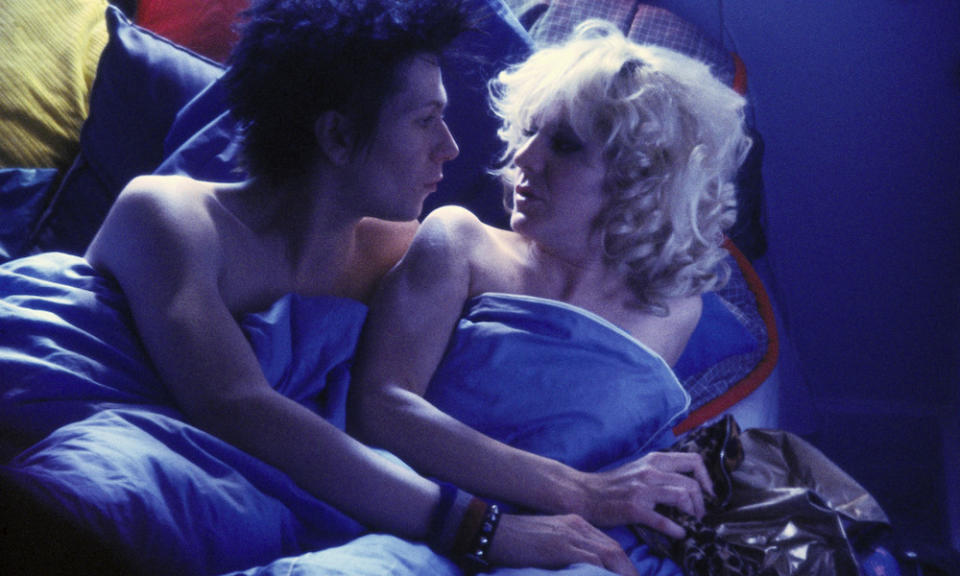
The director Alex Cox brought off something singularly audacious by centering a punk biopic on Sid Vicious, the Sex Pistols’ bassist and all-around showman-fuckup who was so dissolute most of the time that he could barely play his instrument or keep from nodding out. Yet the ultimate audacity of Cox’s film is that it dares to present Vicious’s relationship with Nancy Spungen, the torn-fishnet groupie from suburban Pennsylvania who turned him into a heroin addict, as if they were the Tristan and Isolde of the rock ‘n’ roll gutter. As Sid, Gary Oldman gives what may still be his greatest performance, and Chloe Webb, as Nancy, gives what is simply one of the most powerful performances in the history of cinema. Her Nancy is a caterwauling liar and junkie, such a damaged shard of a human being that it tears your heart apart just to behold her. Nancy and Sid are barely functional narcissist addicts, yet their love affair is fused on an animal level; they need each other to live, and to die. “Sid and Nancy” is raw and exhilarating — the greatest of all music biopics, and (not so incidentally) the most romantic. — OG
21. Moonlight (2016)
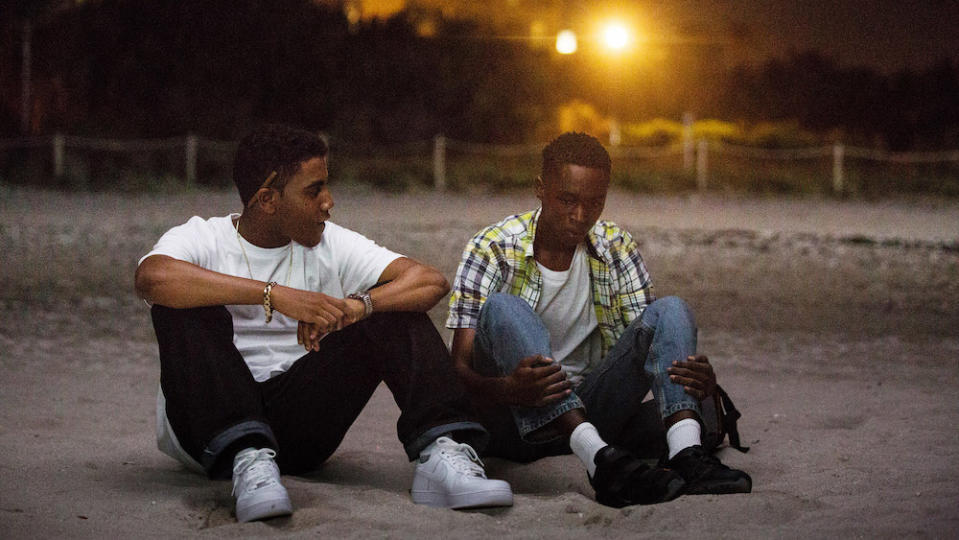
Told through poetic glimpses over three separate chapters in the life of its main character, “Moonlight” doesn’t feel like a love story at first. Director Barry Jenkins introduces Chiron at age 10, too young to recognize his own homosexuality, and yet already being teased as soft by his peers. In the middle segment, the boy meets Kevin, with whom he starts to explore his feelings, only to have that possibility derailed by bullying. Subverting stereotypes at every turn, the movie gives this lost soul a second chance in the final stretch, focusing on a tender, tentative reunion between Chiron (bulked up and thick-skinned from his time in prison) and his former crush. By this point, audiences are so invested in the character that “Moonlight” broke free of the rigid box that confines most queer stories to LGBT audiences, making it a crossover success and historic Oscar winner. — PD
20. The Apartment (1960)
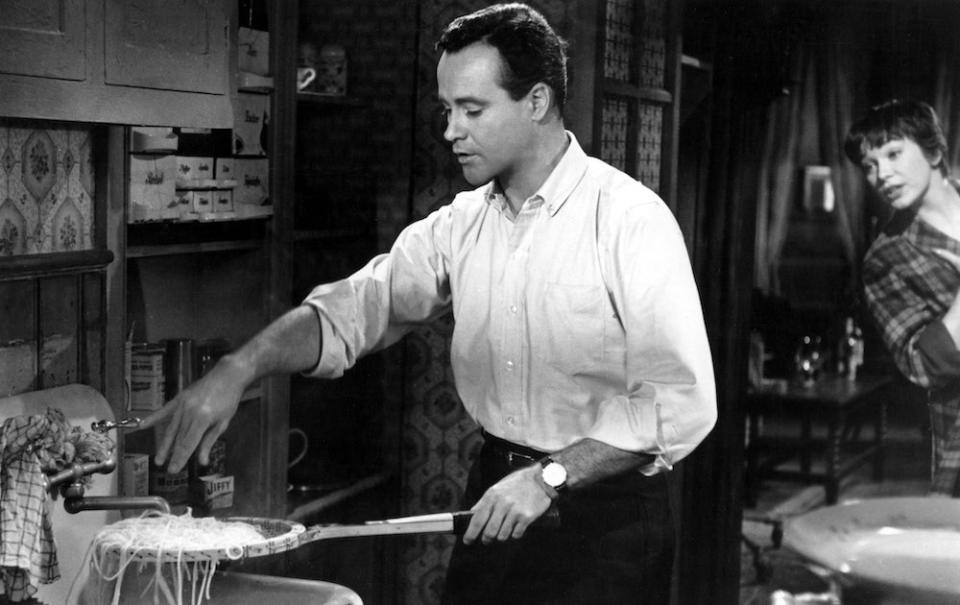
The dialogue still zings and the heartbreak still stings in Billy Wilder’s ahead-of-its-time depiction of two Manhattan office drones who are both exploited by the same manager: Jack Lemmon plays ultra-cynical insurance salesman Bud Baxter, while Shirley MacLaine is Fran Kubelik, the elevator girl who brightens his days … but loves his boss. The plot (which involves Bud lending his place to higher-ups to schtup their secretaries) anticipates the #MeToo movement, while also acknowledging the reality that well-intentioned workers frequently fall for their colleagues. Bud goes about it the relatively respectful way, while Fran’s plight illustrates how unfair the world can be to those who mix business and pleasure. For audiences that love “Mad Men,” but identify with the underdog, the movie poses a wonderfully adult conundrum — one which forces Bud to decide between personal ethics and professional ambition, knowing it could all go sideways for him, career-wise. — PD
19. An Officer and a Gentleman (1982)
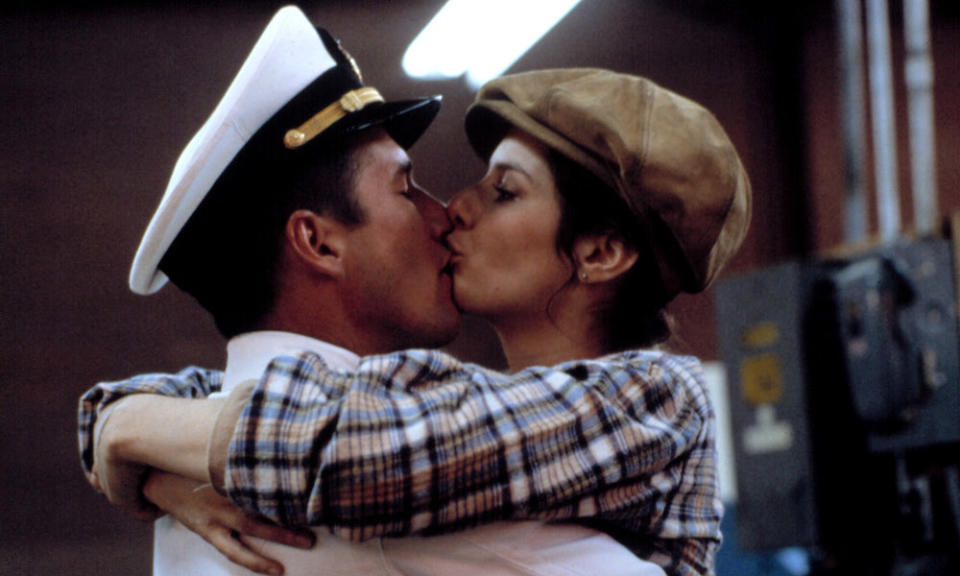
In the New Hollywood ’70s, a great many aspects of classic big-screen romance — the unabashed yearning, the sparkle, the lock-step gender roles — began to fall by the wayside. There was a lot of chatter about how romance itself was fading out of the culture. But that’s part of what made “An Officer and a Gentleman” loom so large. In its meticulous throwback of a story about a drifter, played with pinpoint narcissistic glamour by Richard Gere, who enlists in the Navy and falls for one of the “Puget Sound Debs” (Debra Winger) who want to marry a future jet pilot, the movie seemed to bring back, for the post-feminist era, the kind of shamelessly ardent love story that had fallen out of fashion. It helped that director Taylor Hackford infused it all with a contempo grittiness. As a basic-training movie, “Officer” anticipated much of ”Full Metal Jacket,” but what makes it indelible is the hungry desire enacted by Debra Winger, whose gaze of soulful adoration brings Gere fully alive as a romantic actor. — OG
18. In the Mood for Love (2000)
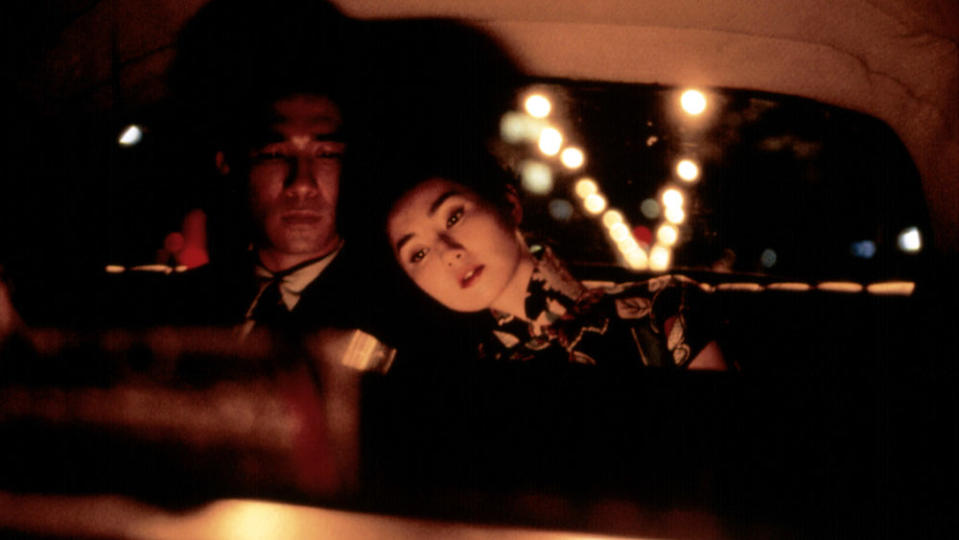
Cinema could hardly conjure a more lovely or elegant couple than cigarette-smoking Tony Leung and Maggie Cheung, who floats through stairwells in form-fitting cheongsams. Operating on the wisp of a plot, improvised and evolved over nearly a year, Hong Kong director Wong Kar-wai denies these two beautiful avatars a conventional romance. They play neighbors who discover that their spouses are having an affair, and rather than sink to the same level, they indulge in a bit of imaginative detective work, reenacting how their partners might have met. This thin outline leaves near-infinite room for Wong to evoke a subjective range of responses from his audience, using the full range of cinematic tools — color, costume, gesture, music — to solicit a different reading from each viewer. Your mileage may vary, but keep in mind: Wong’s a feel-maker as much as a filmmaker, rewriting the rules via this elliptical dance between unrequited lovers. — PD
17. Moonstruck (1987)
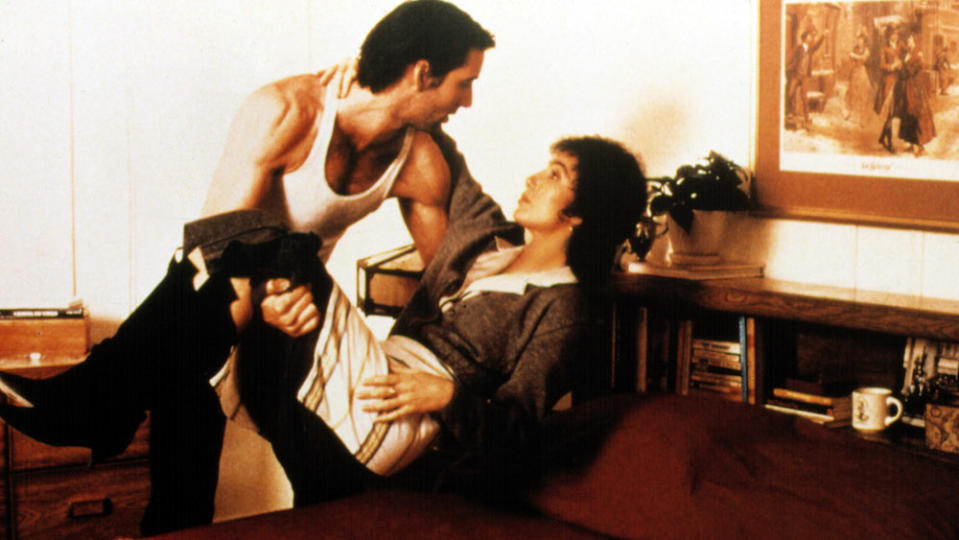
At early test screenings, audiences weren’t falling for Norman Jewison’s now-classic New York romance the way they were supposed to, until he laid the tune “When the moon hits your eye like a big pizza pie…” over the opening credits. Cher tamped down her natural glamour to embody pragmatic Italian-American widow Loretta Castorini, who’s ready to settle for Johnny’s (Danny Aiello) passionless marriage proposal when she meets his brother Ronnie, played by a hot-blooded Nicolas Cage. Let’s just say, Ronnie gives this sensible Catholic woman reason to go to confession. The script by John Patrick Shanley is all but bursting with culturally specific detail, from drool-worthy dishes to unusual superstitions, but it’s the colorful ensemble — family members who want what’s best for Loretta — that ultimately serves to validate her seemingly reckless choice. After a lifetime of listening to her head, she finally decides to follow her heart. That’s amore! — PD
16. City Lights (1931)
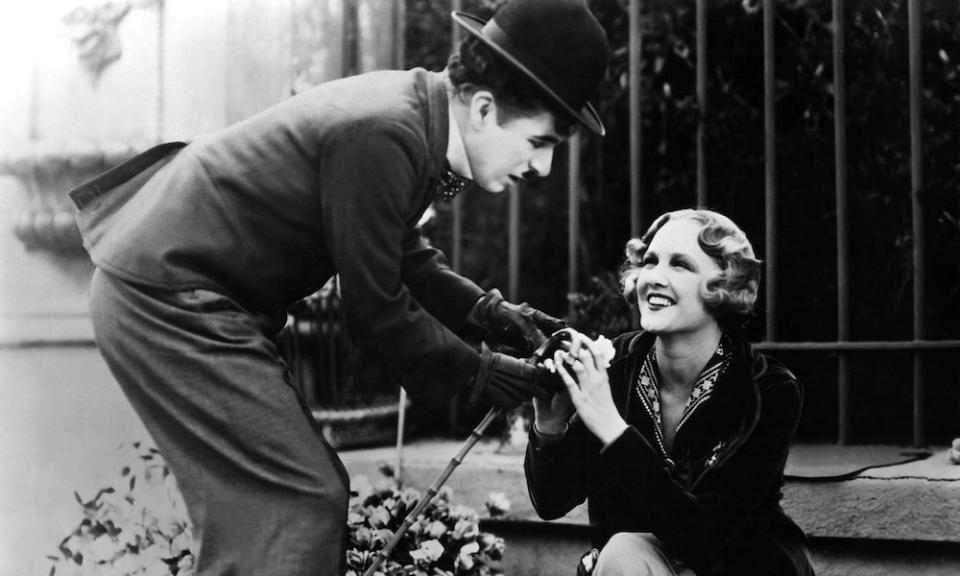
Charlie Chaplin stubbornly resisted the film industry’s embrace of sound, releasing this silent treasure into a sea of talkies. Cinema may have gone a different direction, but his stubborn adherence to pantomime (plus his obsessive need to reshoot every shot until perfect) makes this love story seem all the more timeless, as Chaplin’s signature character, the Tramp, falls for a blind flower seller (Virginia Cherrill). She mistakes him for a wealthy man, and the Tramp allows her to go on imagining him that way in the most poetic version of a familiar rom-com trope ever committed to film: At some point, he’ll have to come clean. Will she still love him when she discovers the truth? The final scene, in which she recognizes the vulnerable fool after her vision has been restored, not by sight but by contact, ranks among the medium’s most romantic. — PD
15. Bonnie and Clyde (1967)

Of the many qualities that made it a revolutionary movie, two stand above all others. The first, and most talked about, is how violent it was — the bystander shot through the eye, the climactic slow-motion blood ballet, and everything else that rubbed the audience’s nose in what being a criminal really meant. But the other quality that defined “Bonnie and Clyde” was how shockingly sultry and romantic it was. The ads for the movie said, “They’re young. They’re in love. And they kill people.” The subtext was that something in the connection between Faye Dunaway’s torrid hunger and Warren Beatty’s vulnerable stud glamour was itself so dangerous that it was lethal. Just check out the two stars’ faces as they exchange one last look before being strafed to death by a hail of bullets. That look is the essence of true love. — OG
14. The ‘Before’ Trilogy (1995, 2004, 2013)

Taken by itself, 1995’s “Before Sunrise” represents the perfect encapsulation of young love: Two strangers meet on a train, get off together in Vienna and spend the night walking and talking (there’s some debate as to whether they make love, as the movie’s too modest to show it). Nine years later, director Richard Linklater delivered one of the most satisfying sequels of all time in “Before Sunset,” reuniting with his two characters, Jesse (Ethan Hawke) and Céline (Julie Delpy), in Paris. Their time is once again limited, but now, the conversation deals with their regrets. But the attraction remains, and the movie ends with the implication they wind up together. But is it happily ever after? Linklater and company caught up with the pair once again with “Before Midnight,” and the movie finds them together, but dissatisfied, acknowledging the challenges that confront couples after nearly a decade together. It was impossible to guess when they first met how deep this relationship would go, and still anybody’s guess how it will end. — PD
13. Annie Hall (1977)
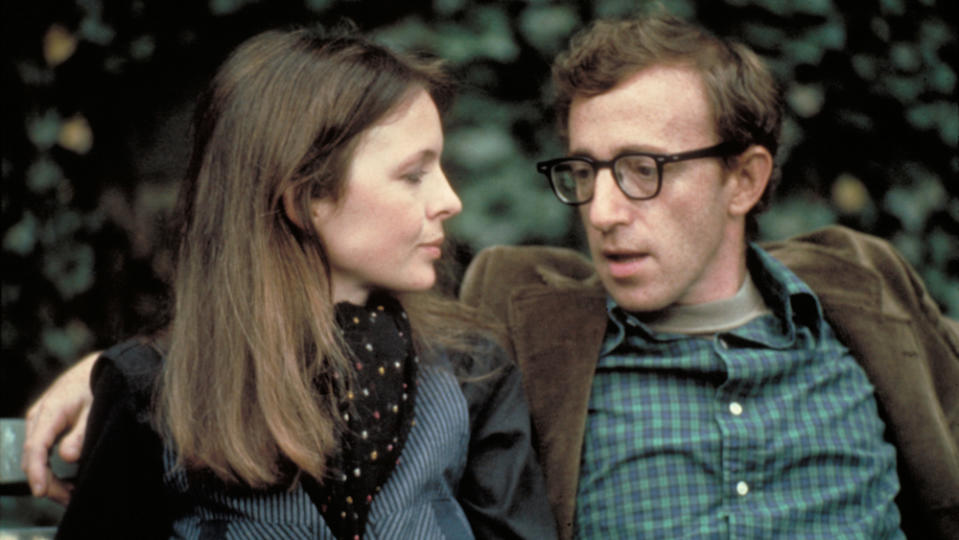
“I lurve you,” says Woody Allen’s Alvy Singer, coming about as close as he can to declaring his feelings for Annie Hall (Diane Keaton), the beguiling thrift-shop space cadet who charmed the world with her la-di-da innocence. Allen’s late-’70s classic was, at the time, a new kind of love story — the saga of a “relationship,” which is to say a partnership not truly built to last. And maybe Alvy Singer had to say “lurve” instead of “love” because, deep down, he wasn’t really sure that he could commit himself to the L-word. Yet the magic of “Annie Hall” is that is channeled how an entire generation had come to regard love in the age of therapeutic navel-gazing: as something intoxicating yet transient, rooted in a seems-like-old-times nostalgia that felt more at home looking back than forward. — OG
12. Jerry Maguire (1996)
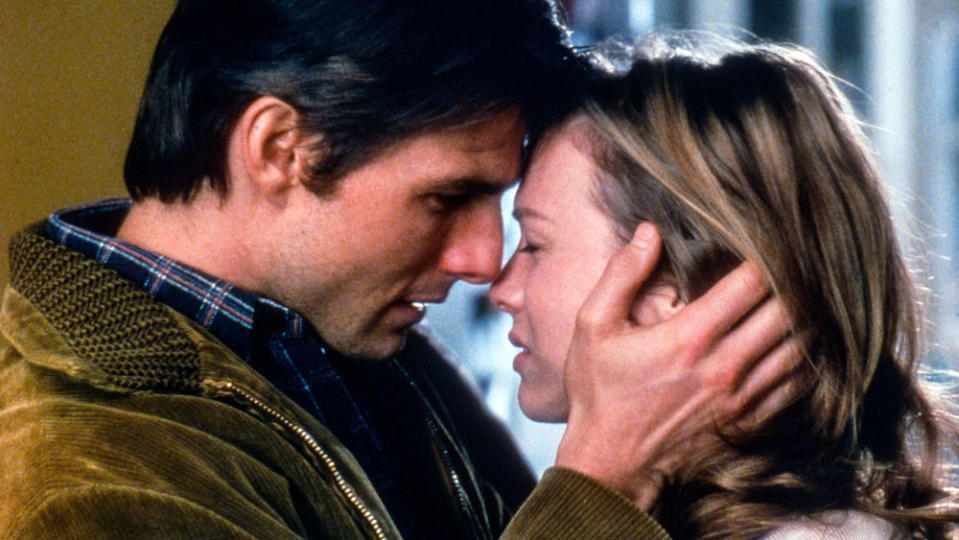
Tom Cruise had always been a solo vessel — a cruise missile of a movie star. It was Cameron Crowe’s inspiration, in casting Cruise as a sports agent who gets tossed out of the game and has to reinvent himself as a better person in order to come back, to pair Cruise with Renée Zellweger, an unknown actor who did not come off like some female-movie-star equivalent of Tom Cruise. She had a homespun allure that seemed to be calling his cockiness, his very stardom, on the carpet. The beauty of the line “You complete me” is that Cruise seemed, at last, to be letting down the guard of a dozen years of mega-stardom. The beauty of “You had me at hello” is that it reminds us of how easy love is when it’s real. — OG
11. Roman Holiday (1953)
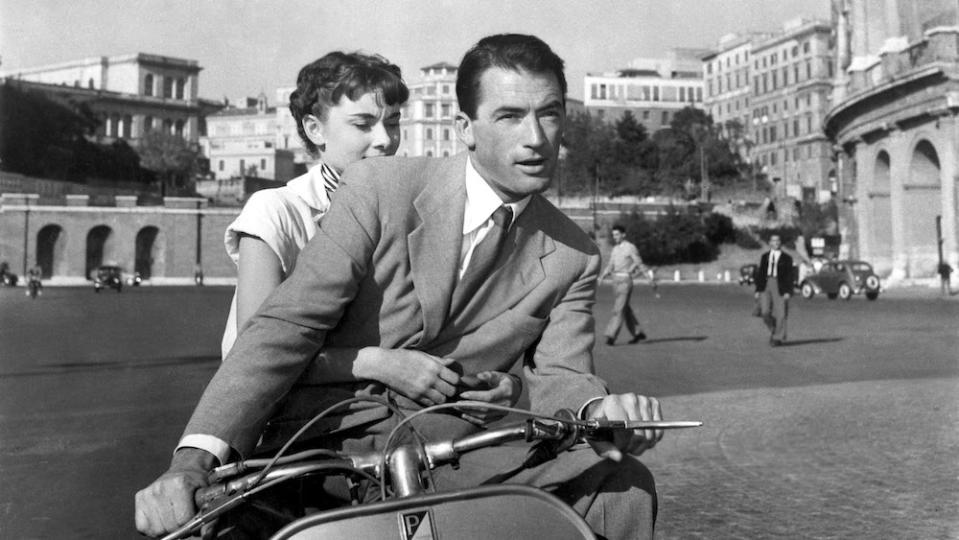
Audrey Hepburn plays the fed-up crown princess of an unspecified country in this escapist romp through the Eternal City. The project kicked off a seven-picture run with Paramount, during which she may as well have been the queen of Hollywood romances: “Sabrina,” “Funny Face,” “My Fair Lady” and more. Suffocating under the obligations of her position, she sneaks out during a European tour, landing in the hands of Gregory Peck’s dishonest (yet honorable) American newspaperman. He thinks he’s hit the jackpot, betting his editor he can deliver an exclusive interview with the princess — but he doesn’t gamble on falling for the dame. Their whirlwind romance lasts but a day, but in that time, the reporter gives Ann/Anya/Audrey a taste of freedom. She plays it coy for most of the movie, but the closeup on her face at the end says it all. — PD
10. Gone with the Wind (1939)
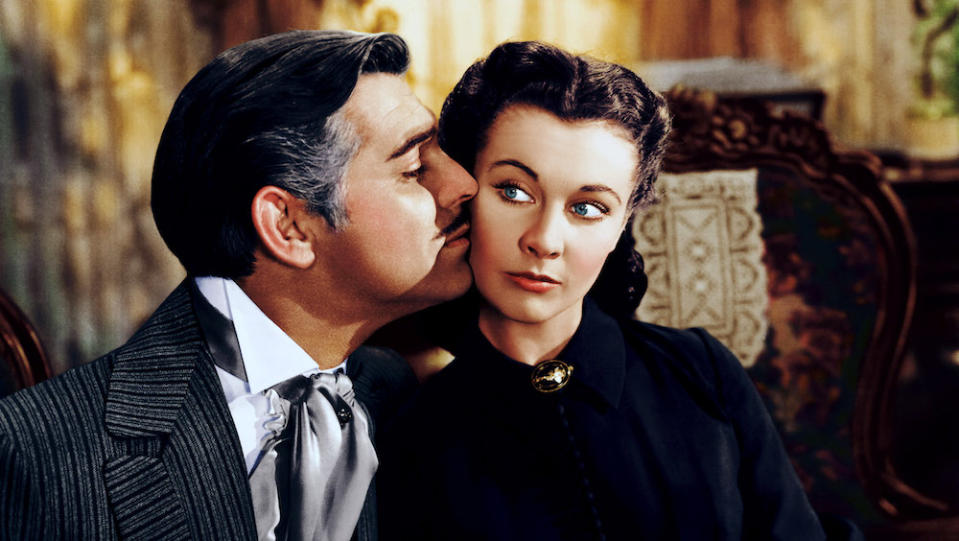
The scene where Clark Gable carries Vivien Leigh up the stairs, with intimations of (to put it mildly) erotic coercion, would not pass muster today. Yet that scene, and others that rhyme with it, are part of what make the most epic of Old Hollywood love stories one of the most darkly complicated and enthralling of Old Hollywood love stories. Leigh’s Scarlett O’Hara is fierce, strong, manipulative — the Southern belle as aristocratic vixen — and so she and Rhett Butler are destined to turn love into a battle that’s doomed to end in a draw. But what heat and light their fireworks give off! “Gone with the Wind” is a movie that’s now seen as “problematic,” yet one of the most seemingly imperfect things about it — the alternating currents of sex and anger, devotion and contempt that fuel the central relationship — is what makes it such a tumultuous classic. — OG
9. The Umbrellas of Cherbourg (1964)
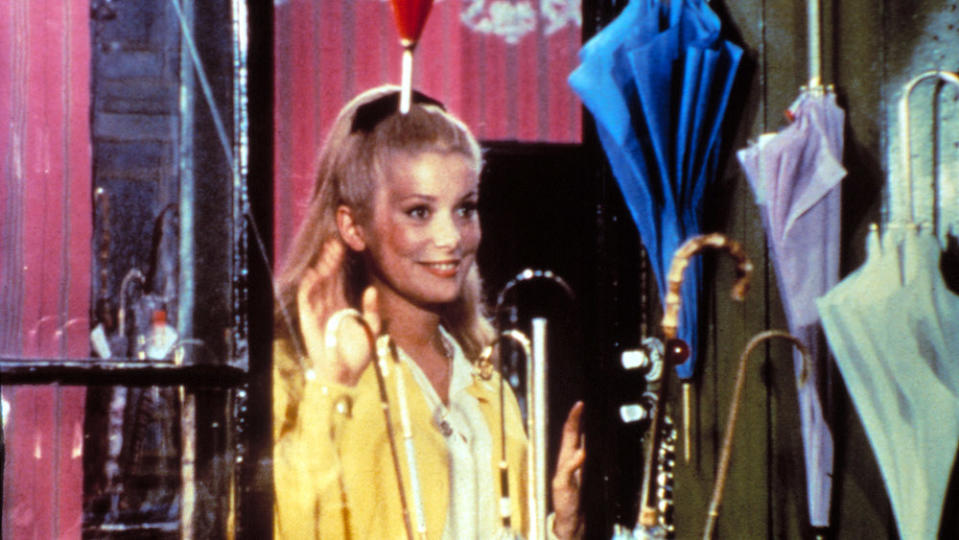
A couple needn’t end up together for a love story to stand the test of time. In the case of Jacques Demy’s bittersweet musical, there’s a relatable quality to the way circumstances keep a working-class French couple from their happily ever after. That downbeat fate serves to balance the bright colors and bold choice of delivering every line of dialogue, no matter how banal, through song. That recitative strategy is common enough in opera, but downright revolutionary on film, still fresh and highly unusual all these years later. Naive young Geneviève (Catherine Deneuve, doll-like at 19) sells umbrellas in the family shop. Guy (Nino Castelnuovo) fixes cars at a nearby garage. They seem destined to be together, until military service calls him away. Michel Legrand’s score leans into the melancholy what might have been in what feels like a snow globe rendering of real life. — PD
8. Brokeback Mountain (2005)
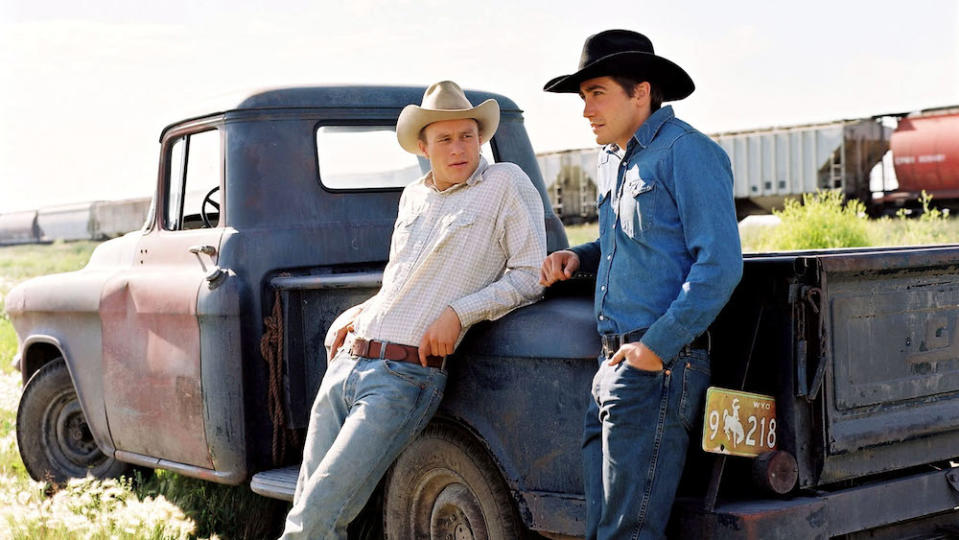
It’s a queer love story set entirely in the closet. Yet by dramatizing the inner lives of two cowboys who find a romantic home on the range in early 1960s Wyoming, Ang Lee’s breathtaking adaptation of the Annie Proulx short story undermined every expectation of contemporary audiences. In showing us two men who discover a love that they themselves think is forbidden, the film dramatizes how prejudice can worm its way into the very fabric of people’s lives; it also demonstrates that the myth of the straight-as-an-arrow American macho he-man is just that – a myth. At the same time, our yearning for Ennis and Jack to make a life for themselves becomes overwhelming in its heartbreak. The performances of Jake Gyllenhaal and Heath Ledger are indelible — and, in Ledger’s case, miraculous, as he turns the muffled, barely articulate Ennis into a living metaphor for a love that cannot speak its name. — OG
7. Ghost (1990)
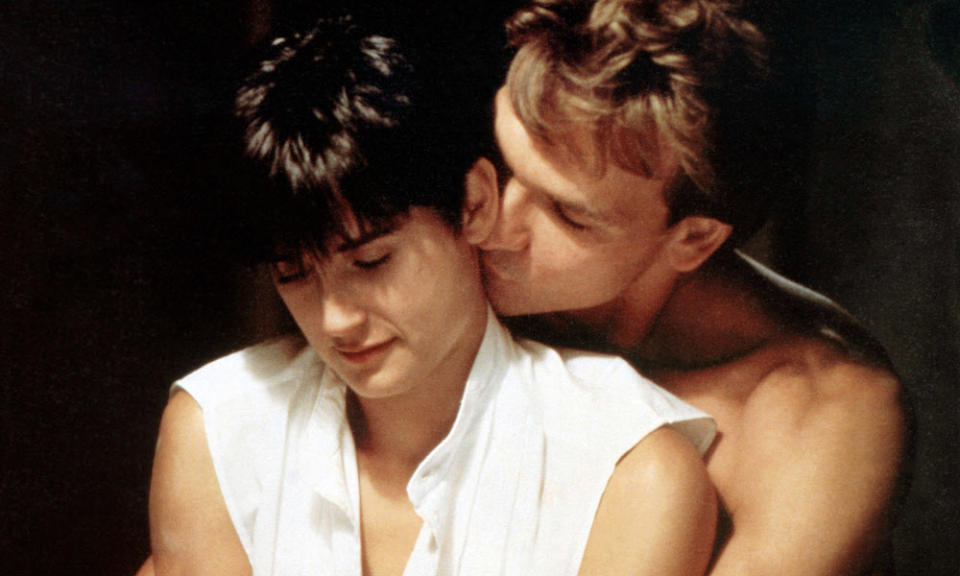
It’s a love story, a ghost story, a corporate crime story, a pottery story, and a movie in which Whoopi Goldberg plays the world’s funniest cut-up mystic. But who would have guessed that just four months after “Pretty Woman,” it would be the headiest romantic movie of its year? The director, Jerry Zucker, was a veteran of the “Airplane!” troupe, yet somehow he juggled all these elements to touch a chord of pure fairy-tale rapture, spinning out the story of a New York banker who’s killed by a mugger and returns as a ghost to protect his artist girlfriend. The way Patrick Swayze and Demi Moore bond across the ectoplasmic divide is at once thrilling and moving (true love, it seems, knows no restrictions, from either physics or the spirit world). The film turned the Righteous Brothers’ “Unchained Melody” into a retro smash, but only because of how it tapped the film’s emotions: intimate, operatic, quavering with devotion. — OG
6. Brief Encounter (1945)
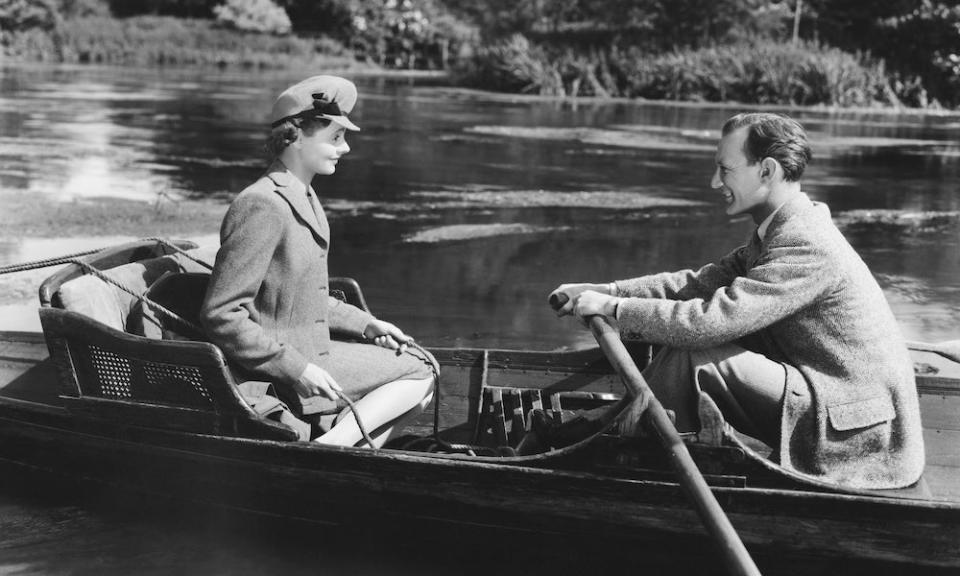
It all began with a little piece of grit in her eye. Fortunately — or not — for Laura Jesson (Celia Johnson), a doctor was present to remove the offending particle, and when her vision cleared, there he stood, Dr. Alec Harvey (Trevor Howard), handsome and kind. The train station where this meeting happens serves as a kind of romantic purgatory, with each locomotive that steams through reminding Laura and Alec of their obligations to their actual partners. But every Thursday, they meet in town, too weak to resist the growing love between them — feelings which the conservative forces of the time could not condone, but which spoke to a human experience too widespread to go ignored. And so David Lean’s slender, achingly honest film has stood for years, staunchly refusing to judge two would-be adulterous souls, letting audiences in on a secret that even their spouses don’t suspect. — PD
5. A Star Is Born (2018)
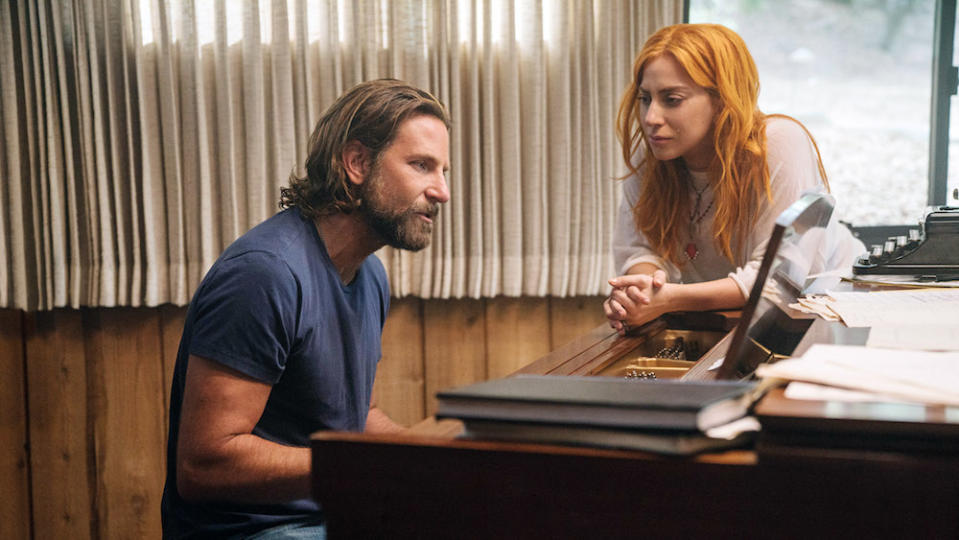
It’s a seesawing Hollywood love story that’s been told on the big screen close to half a dozen times, yet never more powerfully or artfully than by Bradley Cooper in his astonishing directorial debut. From the bombastic kitsch of the 1976 Streisand/Kristofferson version, Cooper borrowed the idea of turning the central character into a rock ‘n’ roll star, and his performance as Jackson Maine — a half-deaf drunken burnout, running on fumes, even though he’s able to fool the world into thinking he’s still a rock god — grounds the soap-opera story in something disarmingly earthy and real. When Jackson meets Ally (Lady Gaga), a budding singer-songwriter, and invites her onstage to sing “Shallow,” you will get chills the way few romantic movies have given them to you — and the tremors don’t let up, as the two get on a serpentine roller-coaster of love vs. jealousy, arena rock vs. dance pop, and tragedy slipping into redemption. — OG
4. Moulin Rouge! (2001)

Baz Luhrmann’s visionary jukebox musical is in love with a lot of things: the look and feel of faux 1890s sound-stage Paris (that nightclub windmill etched in light), the epiphany of pop songs like Elton John’s “Your Song” when they pop up in what should be the wrong place (but then why does it feel so right?). Mostly, though, the film is in love with Christian and Satine, the romantic bohemians played by Ewan McGregor and Nicole Kidman, who summon gazes of such doomed longing that the film’s ultimate love affair seems to be with love itself — the unearthly kind, the kind that lives as an impossible dream. — OG
3. To Catch a Thief (1955)

From “The Awful Truth” to “An Affair to Remember,” Cary Grant enjoyed a two-decade run as Hollywood’s most dapper leading man, romancing everyone from Katharine Hepburn to Ingrid Bergman, sometimes multiple times over. But it was paired with impossibly elegant star (and future princess) Grace Kelly that Grant sparkled brightest, playing a notorious jewel thief who finds Kelly’s wealthy American tourist even more irresistible than her invaluable diamond necklace. Like a well-practiced cat burglar, this sprightly Hitchcock movie tiptoes so lightly it hardly touches the ground, sweeping audiences away to the chicest of locations on the French Riviera. Whether it’s the scene of Kelly’s gems outdazzling a fireworks show (she stands in the shadow while her diamonds glisten in full view of Grant) or the hilltop picnic overlooking Monaco, the vibrant full-color fling gave landlocked Americans a fizzy Mediterranean fantasy featuring the most distinguished couple imaginable. — PD
2. Titanic (1997)
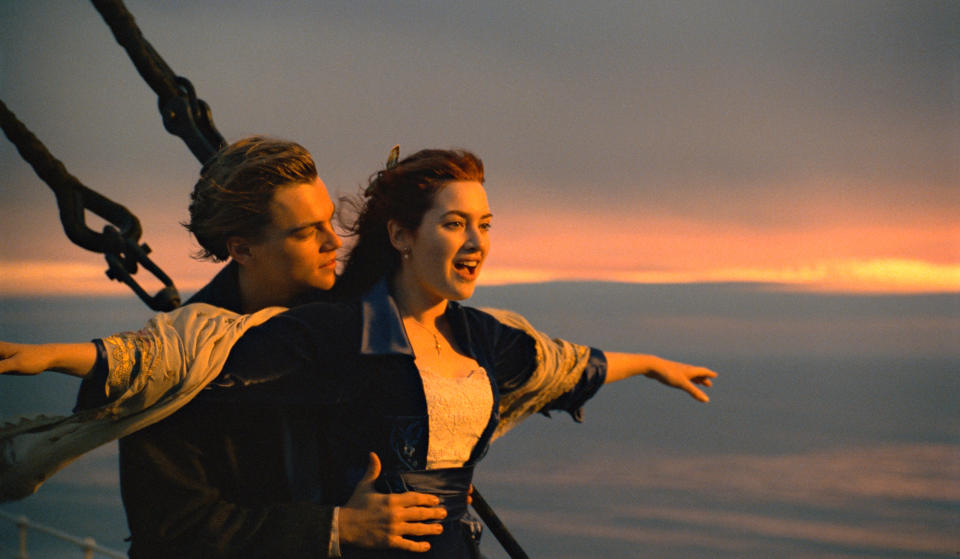
The swooniest romantic movie of its time, and also the most sublime, James Cameron’s ocean disaster epic is the rare Hollywood blockbuster that achieves a larger-than-life quality. Yet its secret weapon as a love story is the too-often-unacknowledged deftness of its storytelling. As Jack and Rose, the sweethearts from opposite sides of the class divide, Leonardo DiCaprio and Kate Winslet have an effervescent chemistry, yet they’re playing starry-eyed youths caught in a puppy-love fling. The implication is that their union might last just about as long as the Titanic’s voyage — were it not for that fateful iceberg. In “Titanic,” it’s disaster itself that elevates love into something timeless. — OG
1. Casablanca (1942)
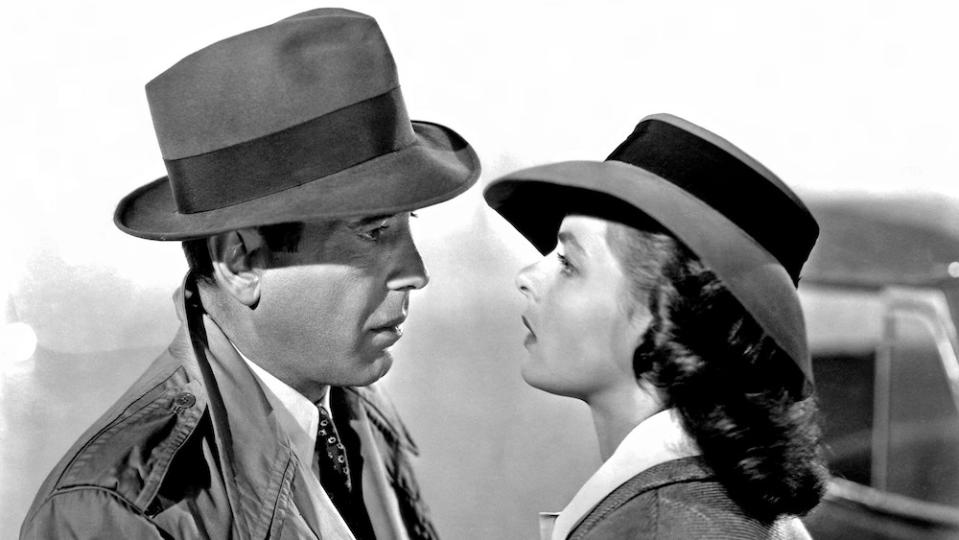
It was often said that in the 20th century, the movies taught people how to fall in love. You certainly know that watching “Casablanca.” In all of cinema, there is no love connection more pure, more impassioned, more haunted by the past, more alive in the present, more complicated by circumstance than the one between Rick (Humphrey Bogart), the expatriate owner of a shady Moroccan nightclub and gambling den, and Ilsa (Ingrid Bergman), the woman he fell in love with in Paris in 1940, only to be abandoned by her for mysterious reasons. Do they still love each other? The answer to that is as simple as listening to Sam (Dooley Wilson), the saloon pianist, play “As Time Goes By” and hearing that it’s really about how a kiss is just a kiss…for all time. Yet if Michael Curtiz’s ageless Hollywood classic celebrates what love is, it’s also about the deepest level of what love means: not just rapture but sacrifice, devotion to the other, a giving over of oneself to something larger. “Casablanca” remains the ultimate big-screen romance, in part because Bogart and Bergman show us that love is a force within us powerful enough to connect to — and save — the world. — OG
Best of Variety

